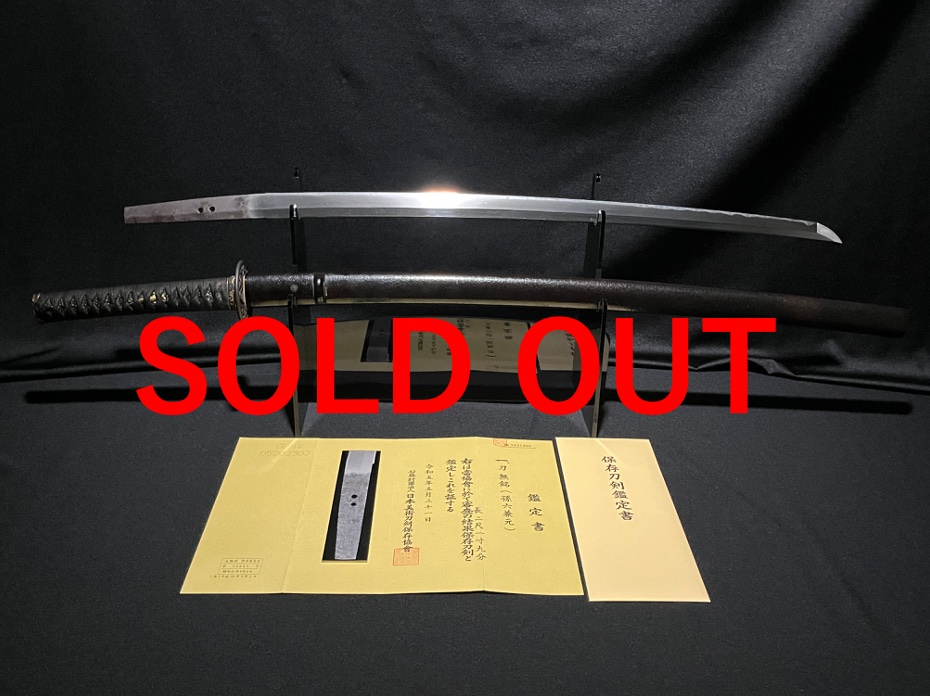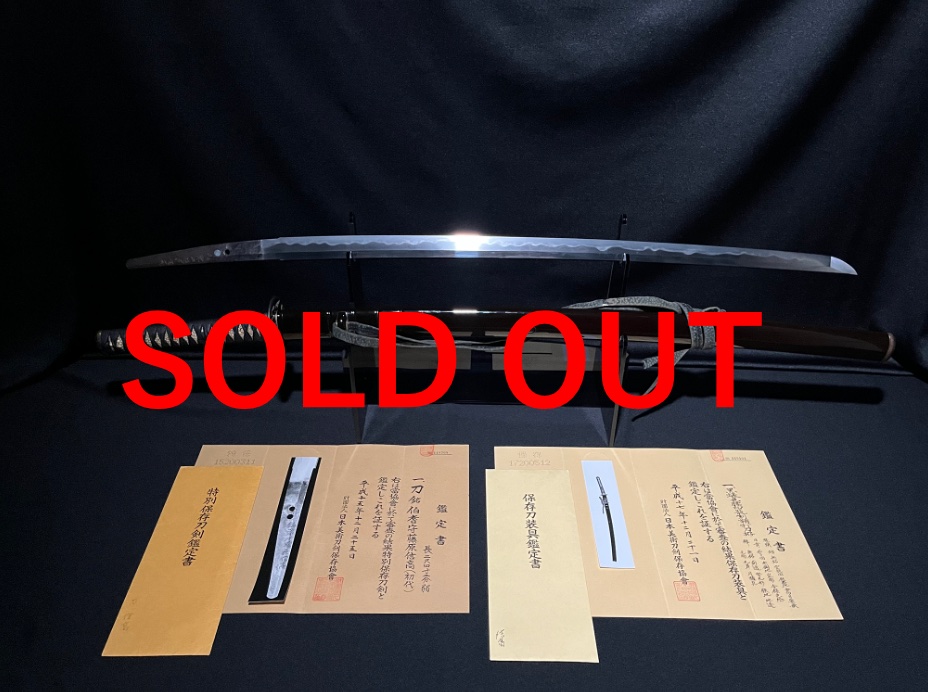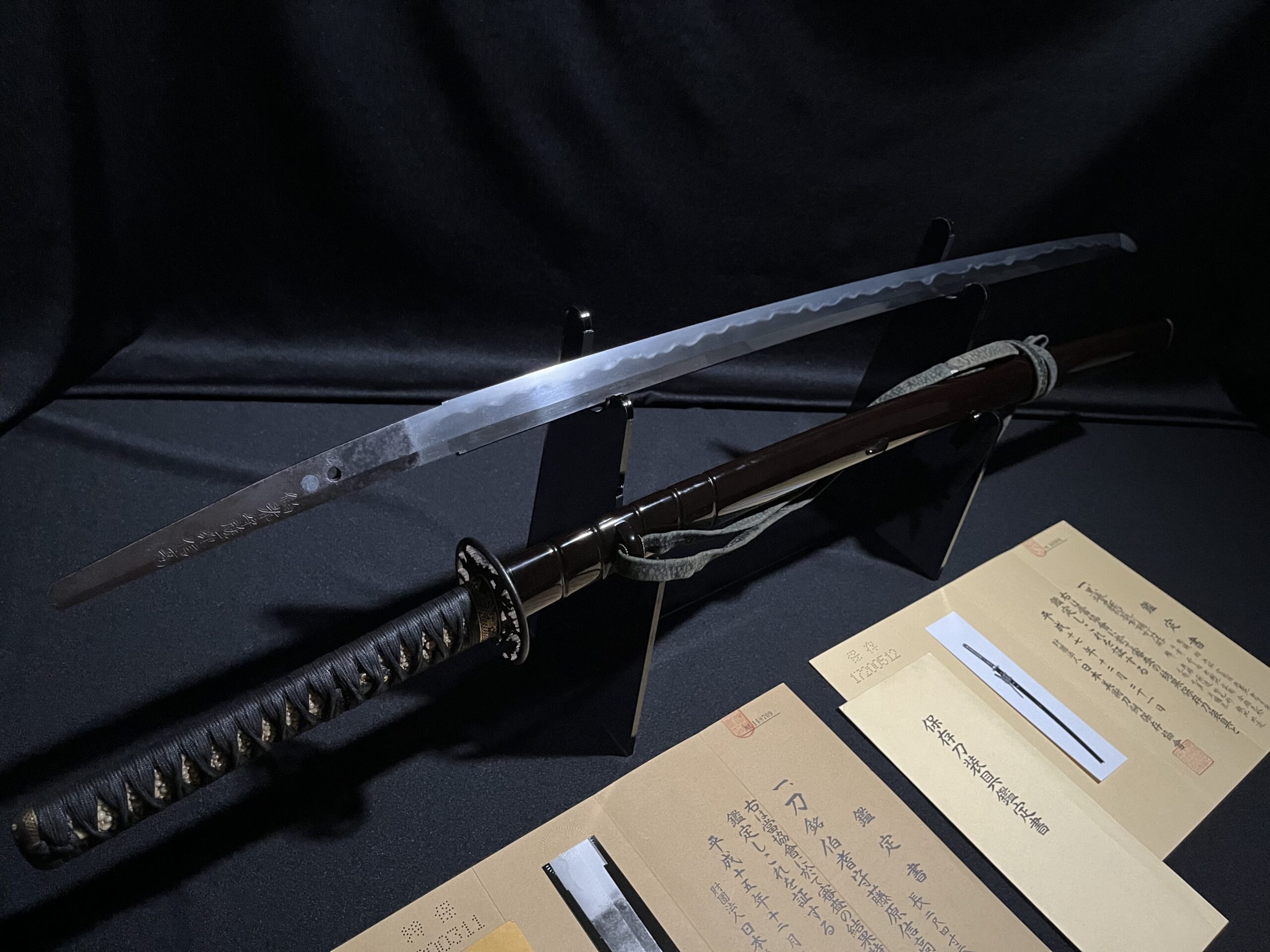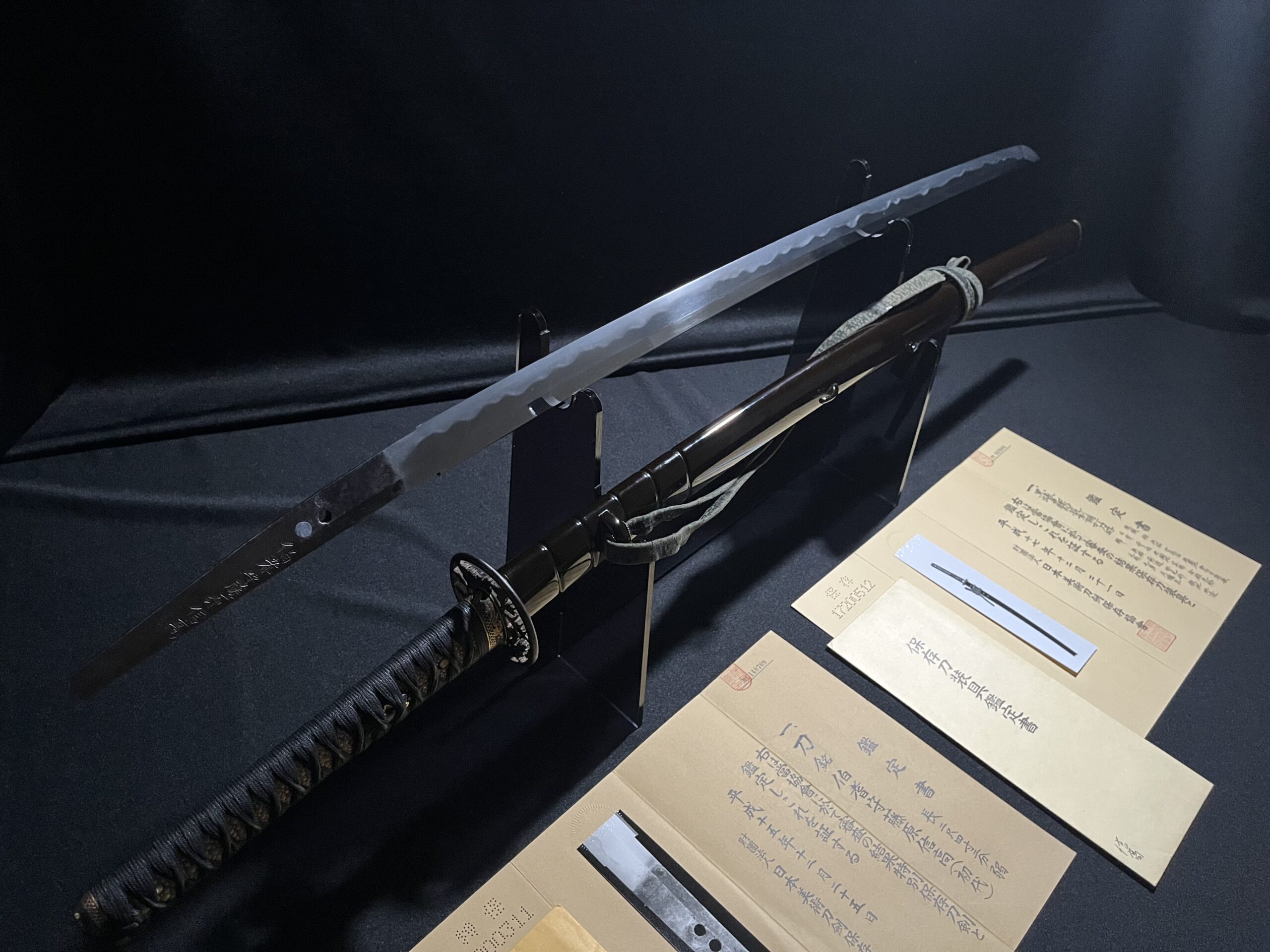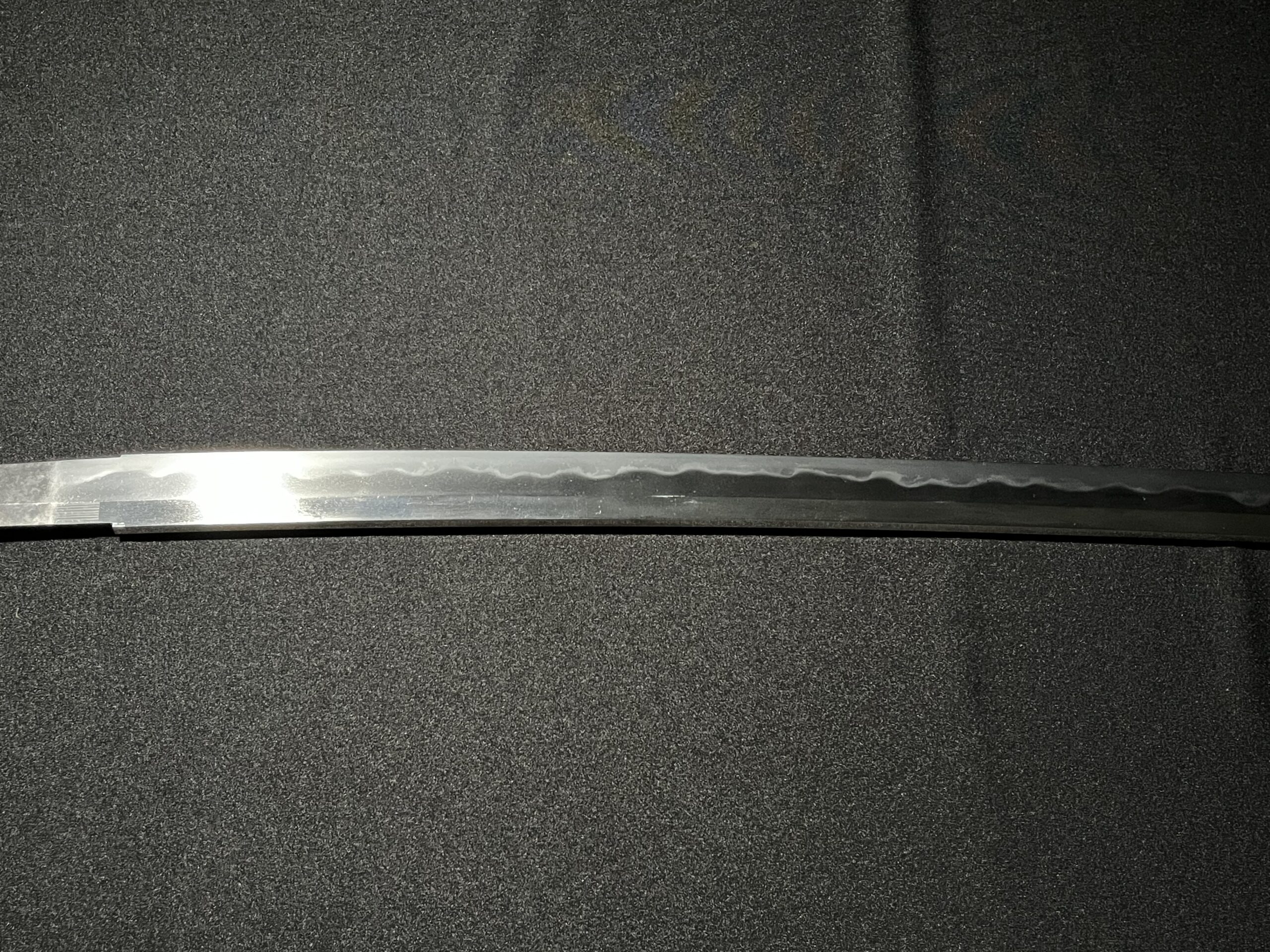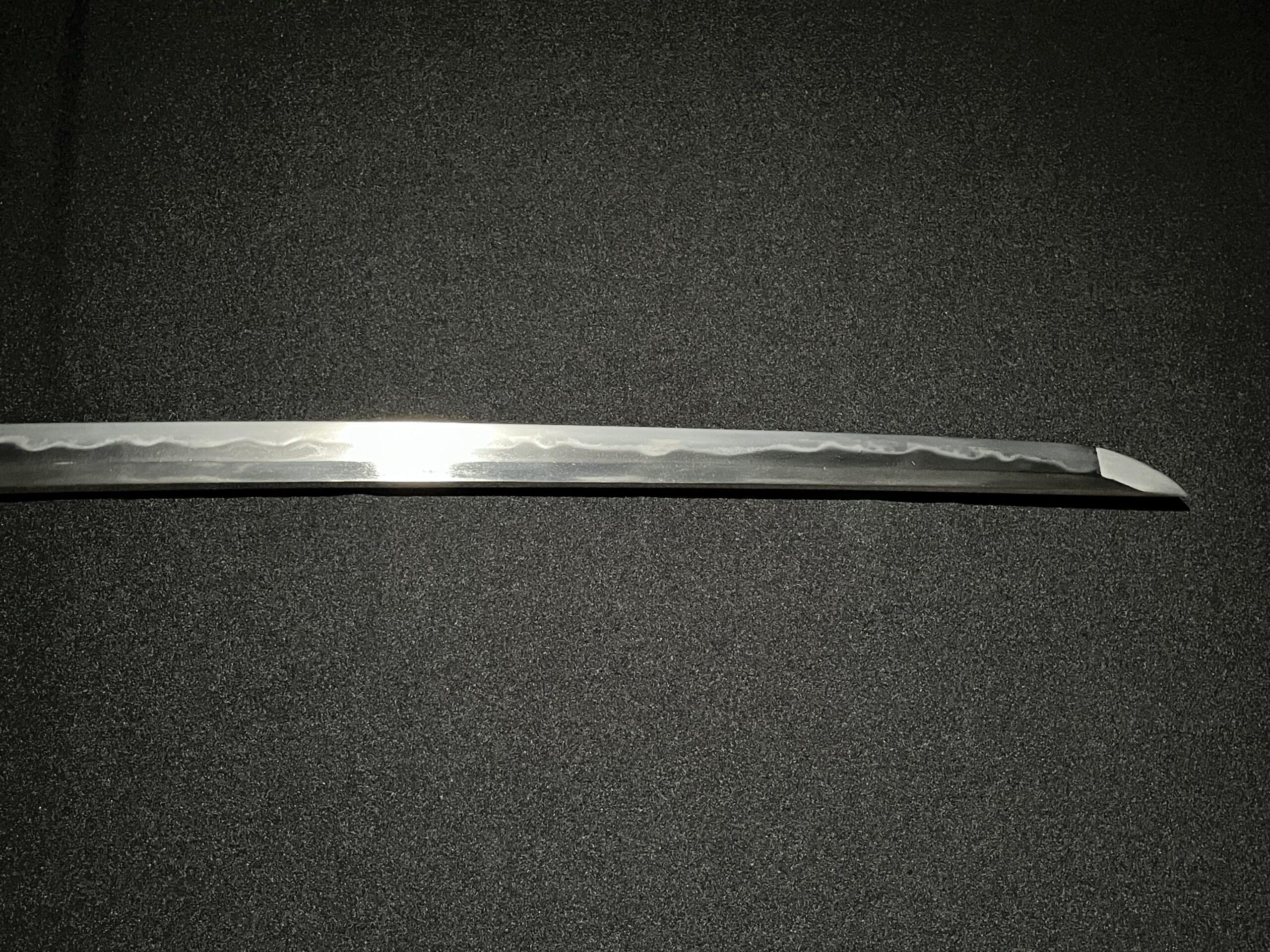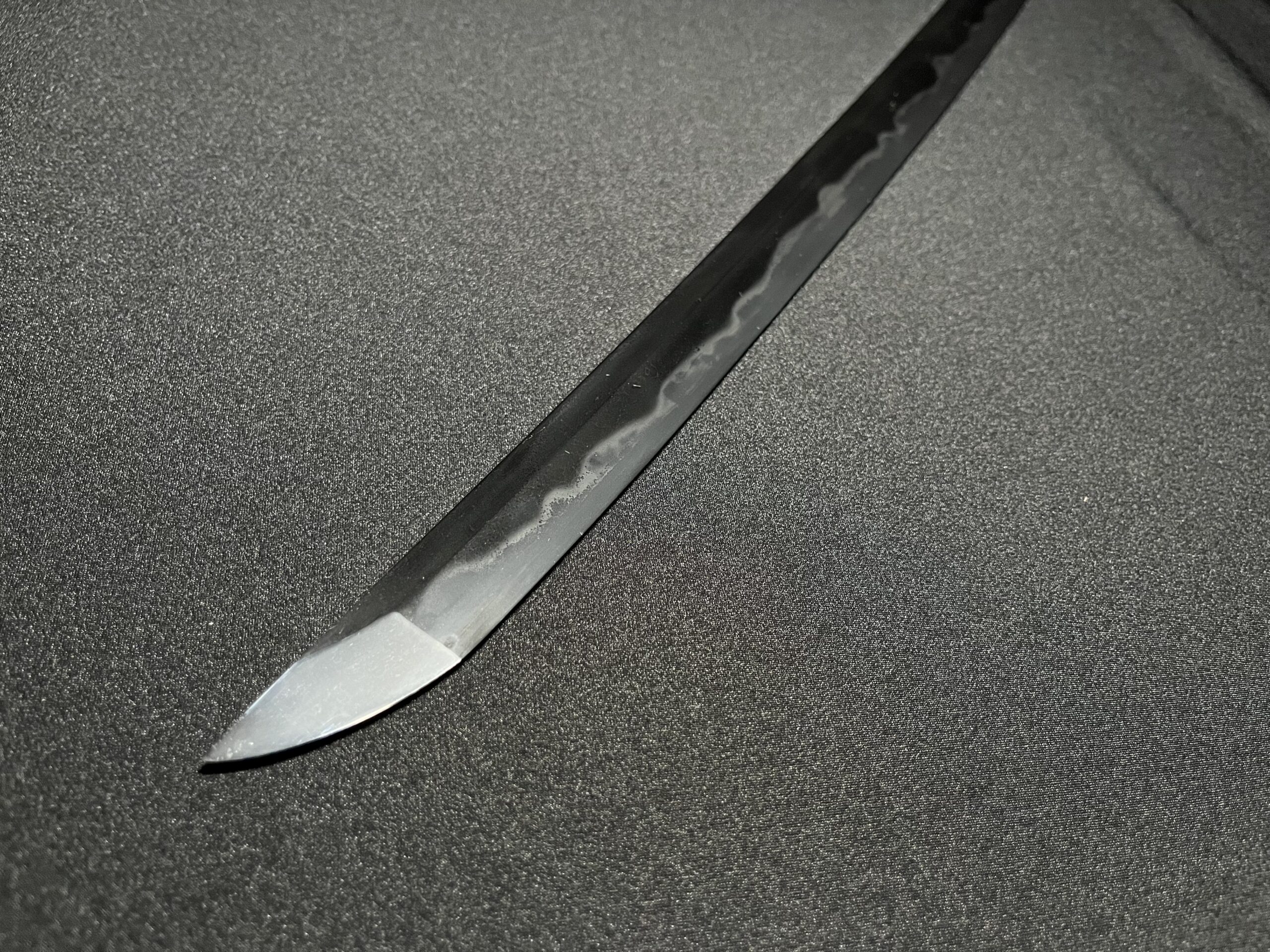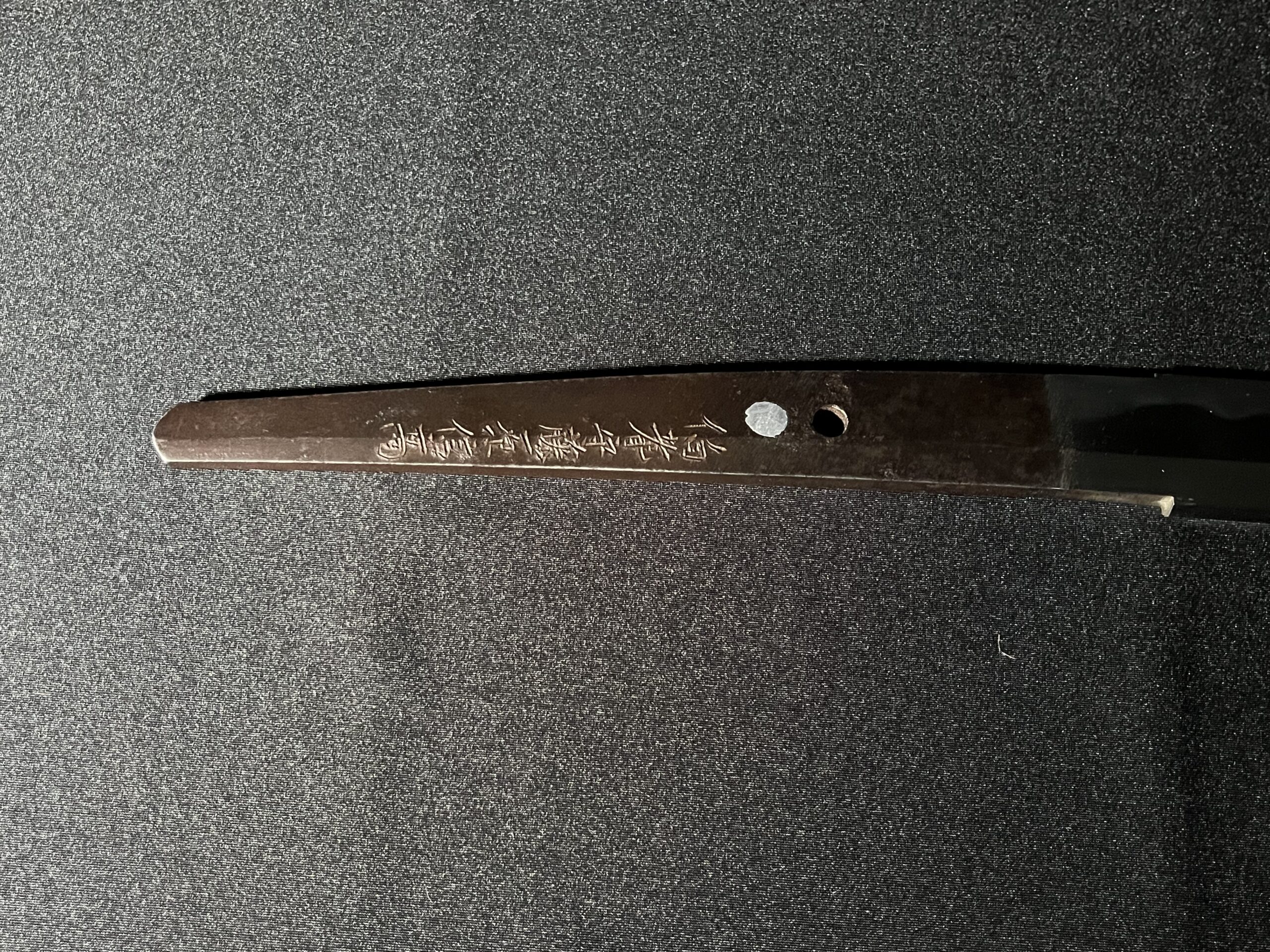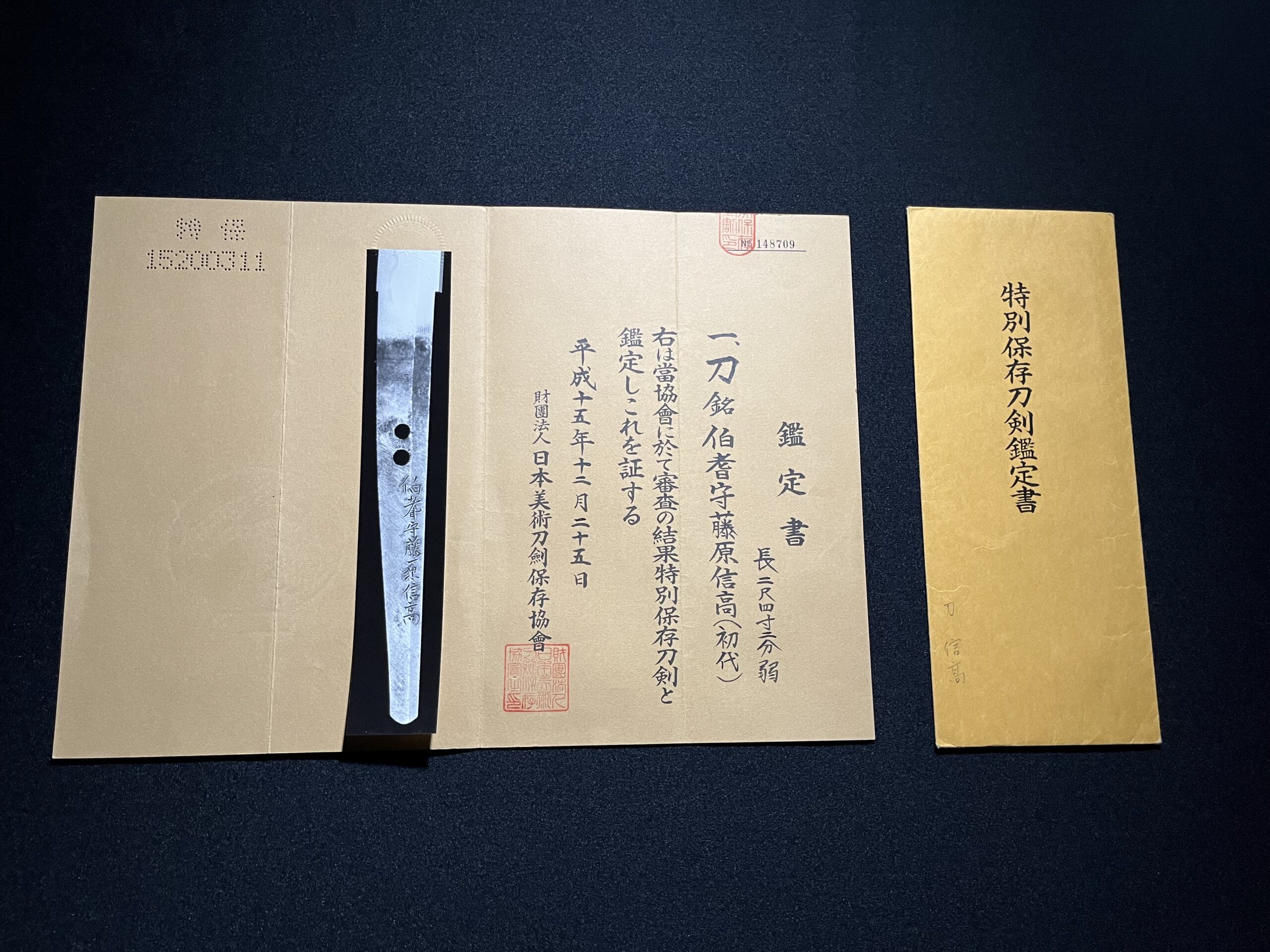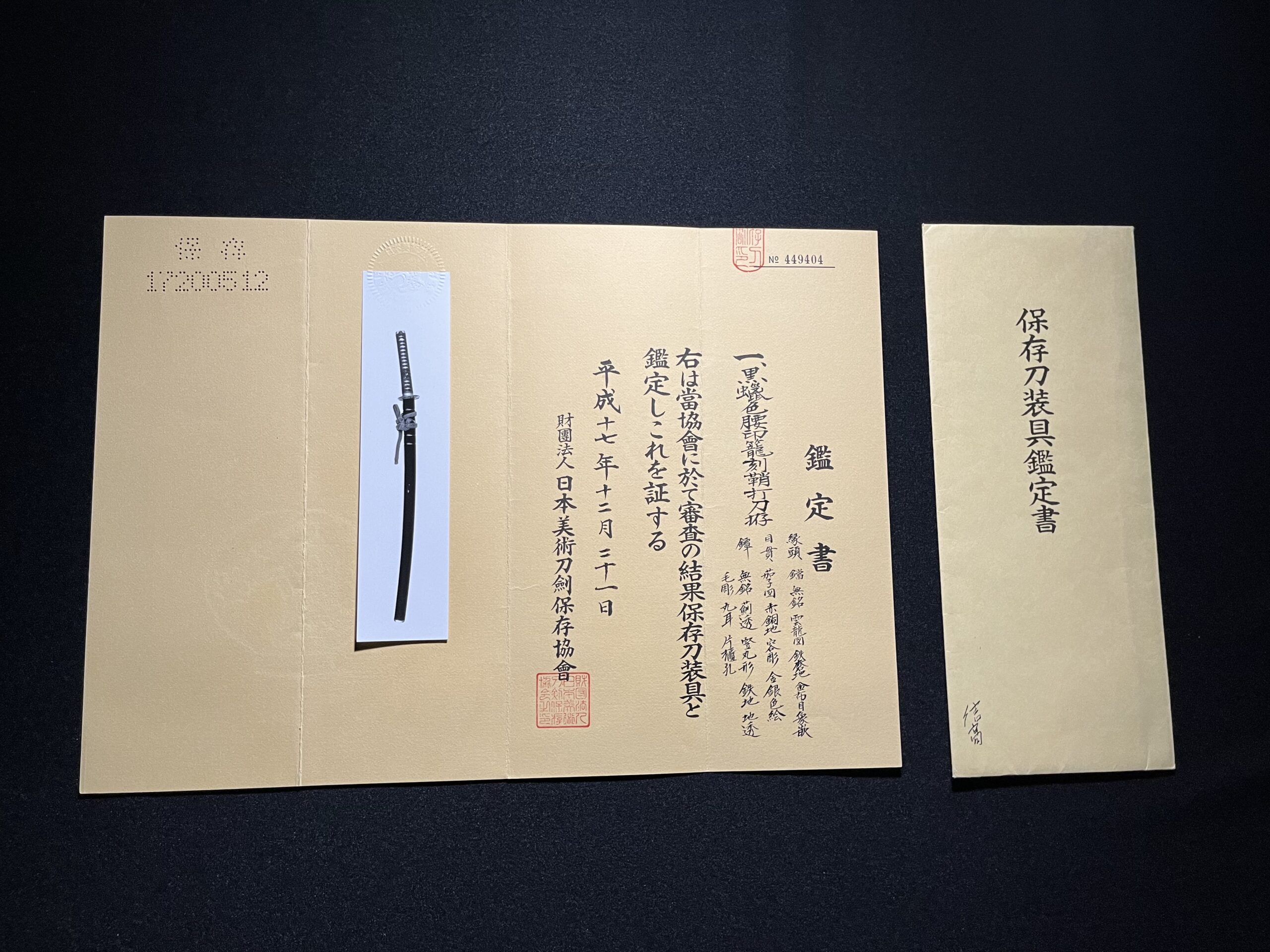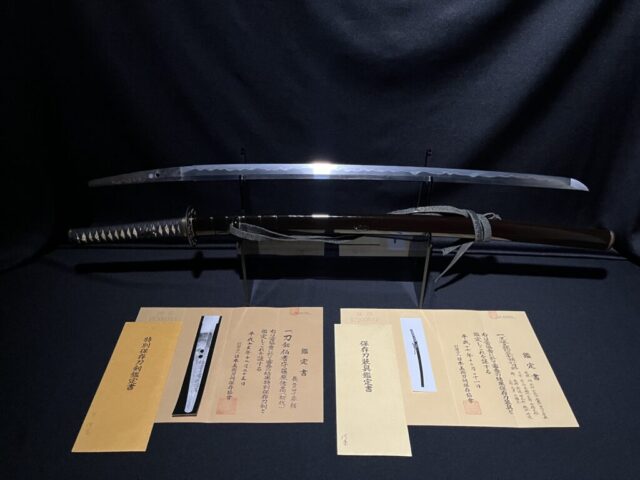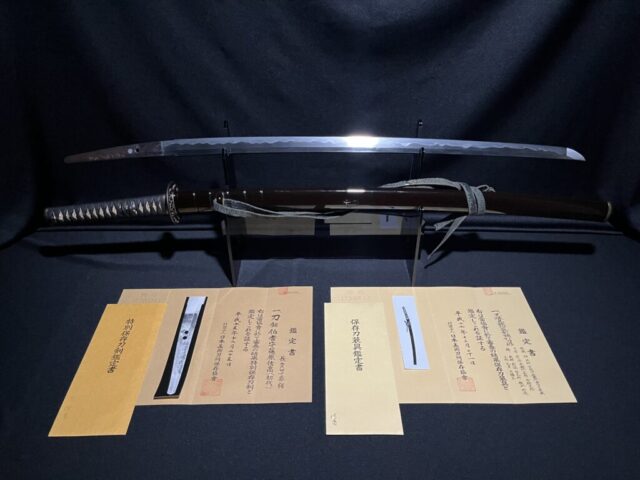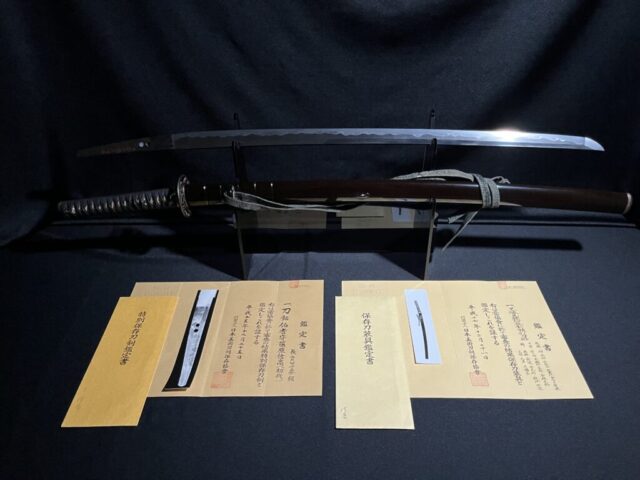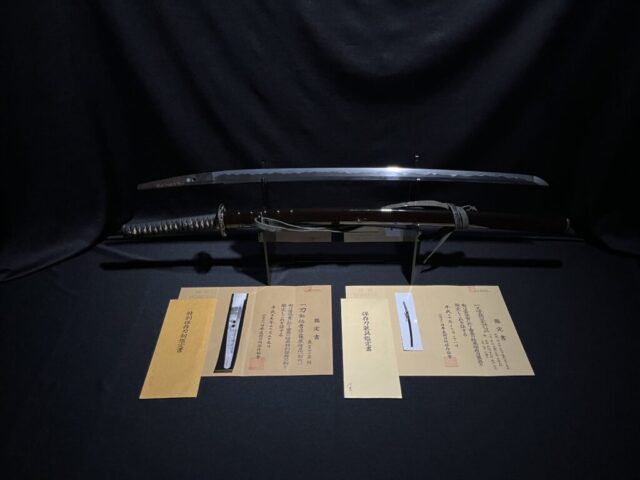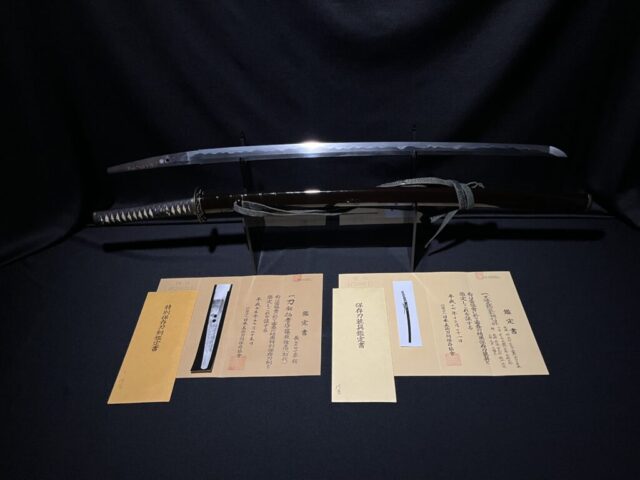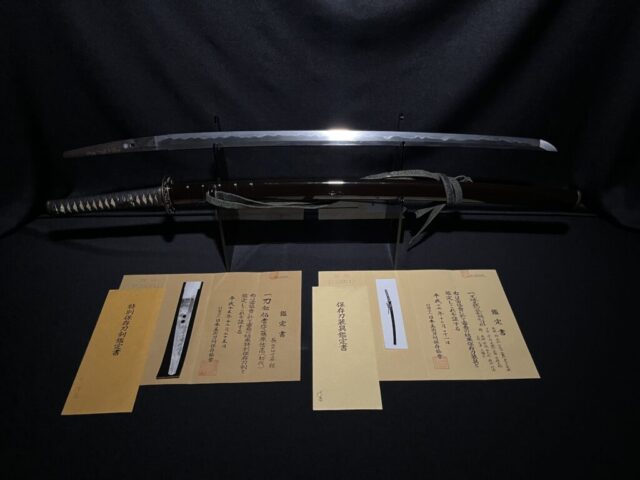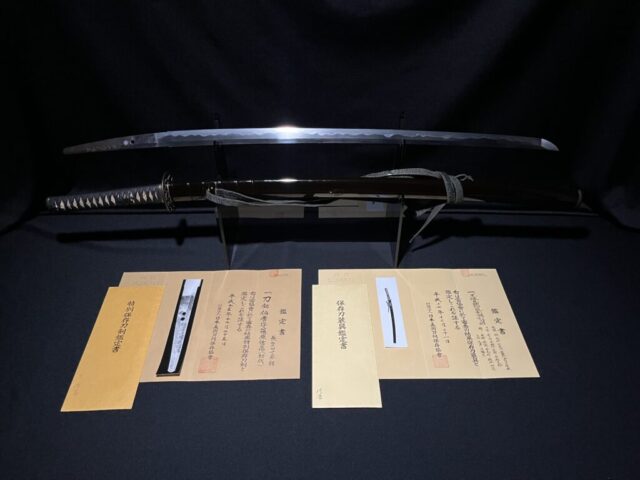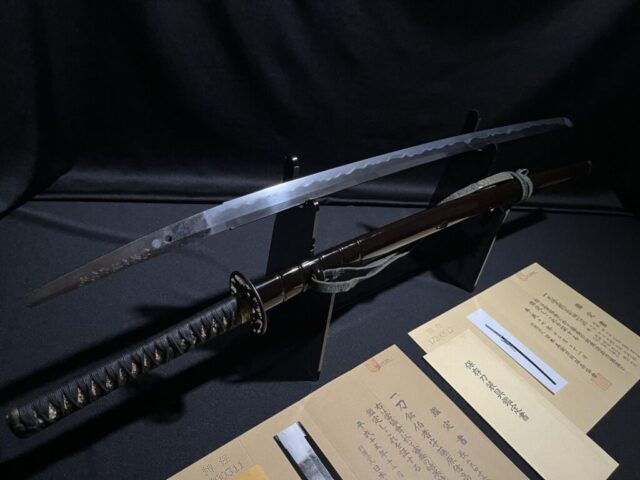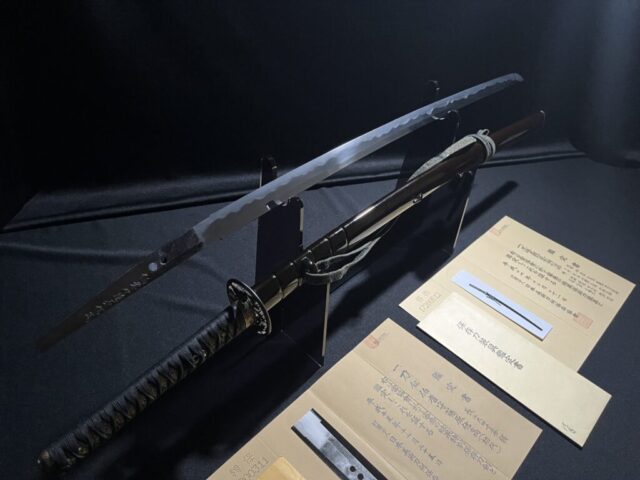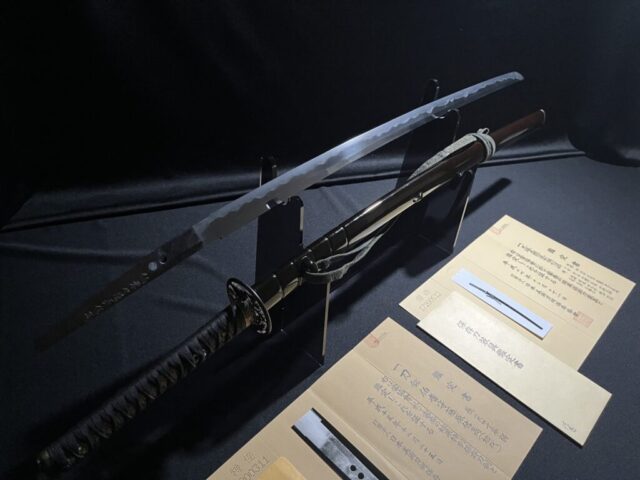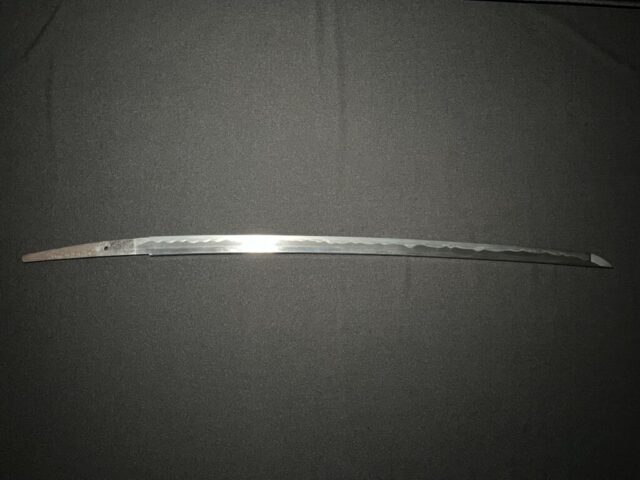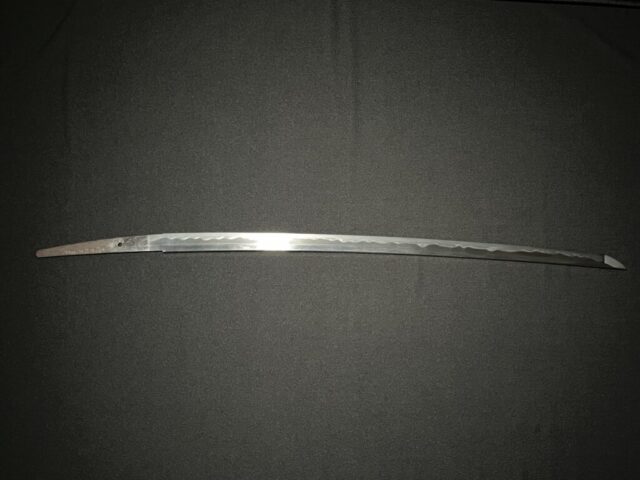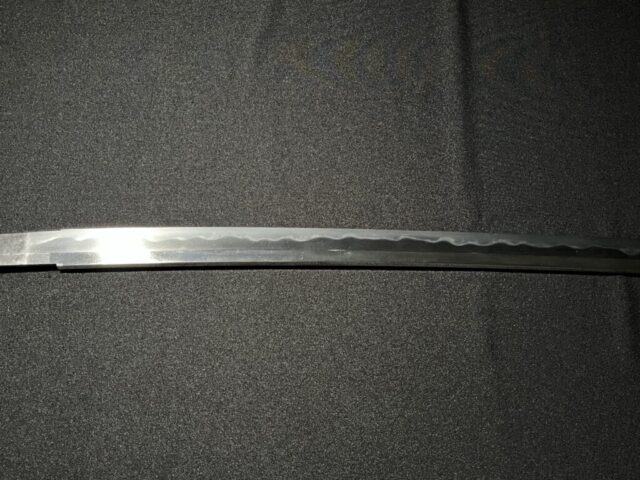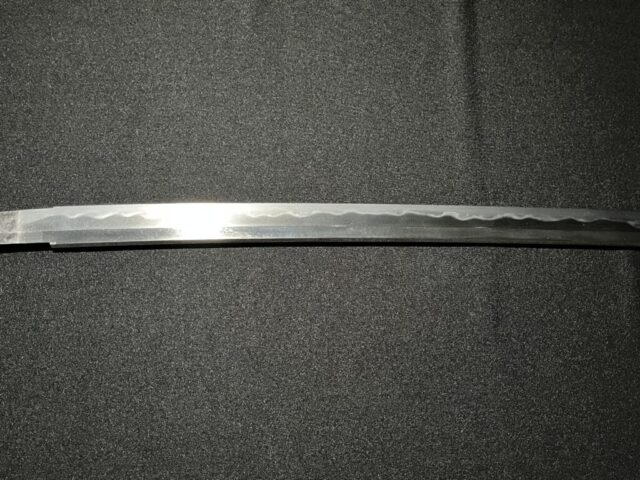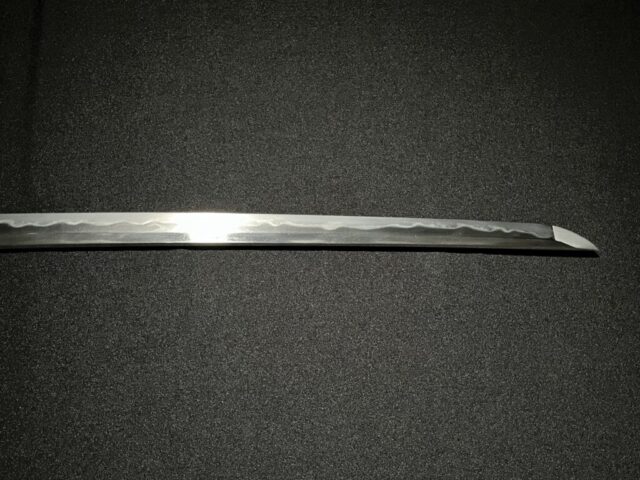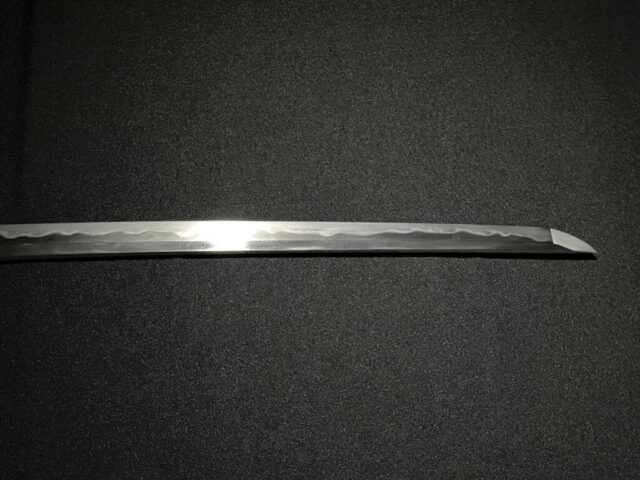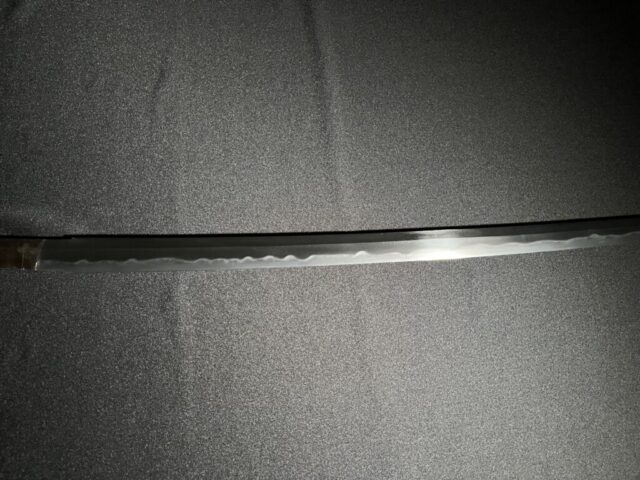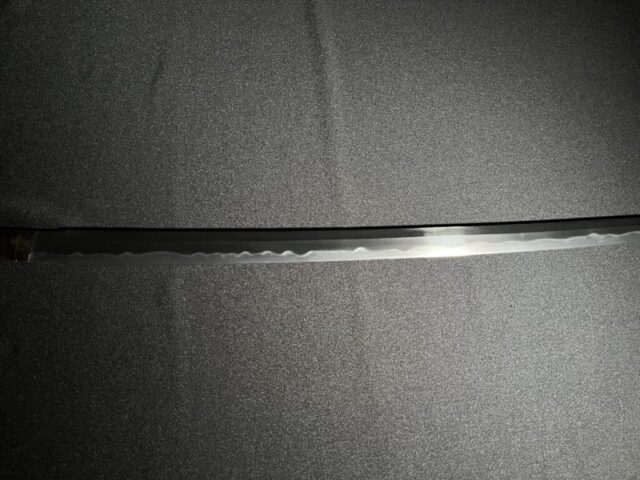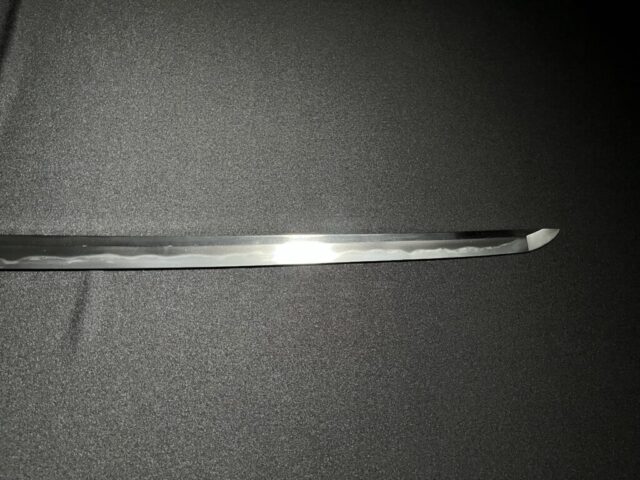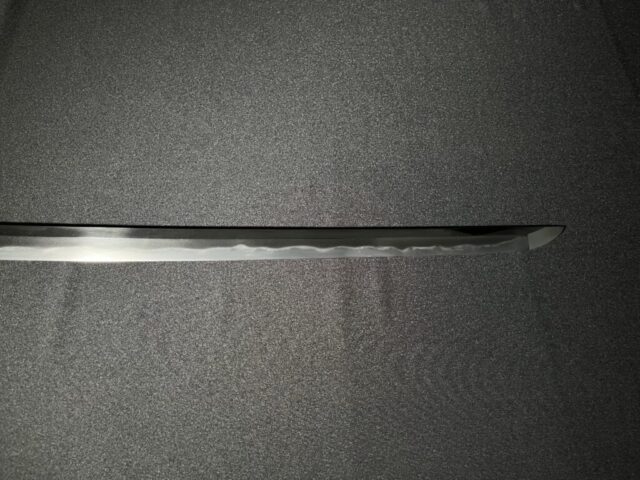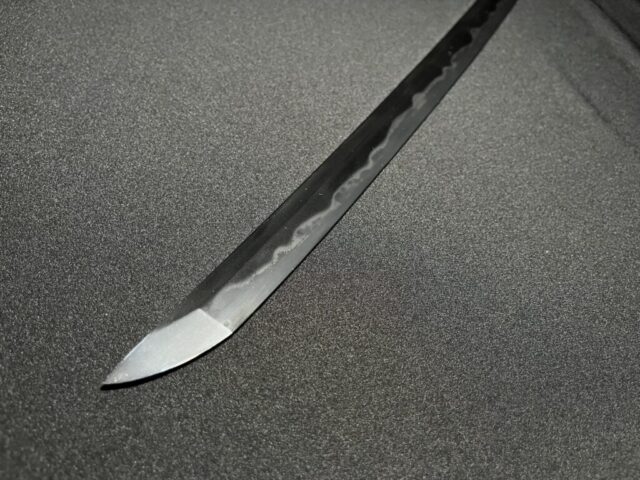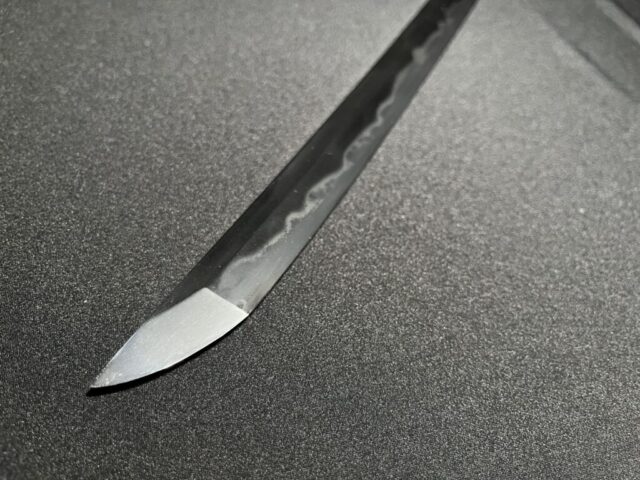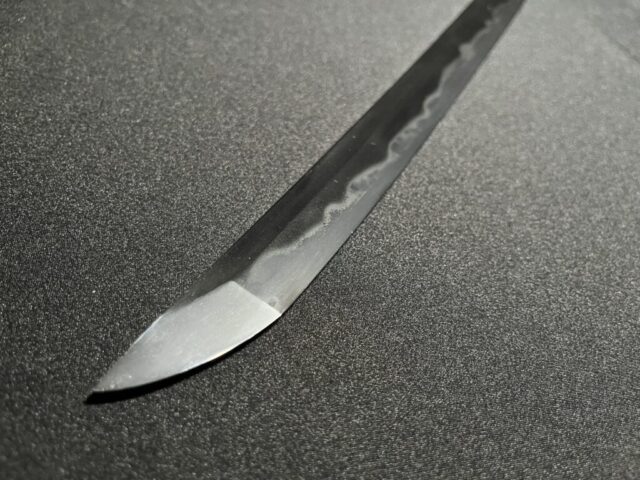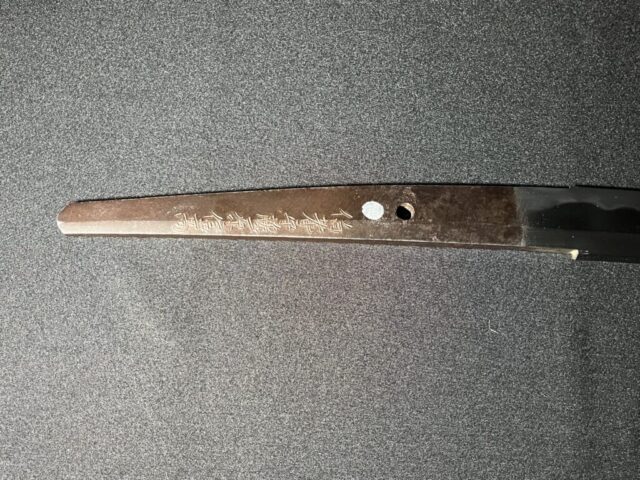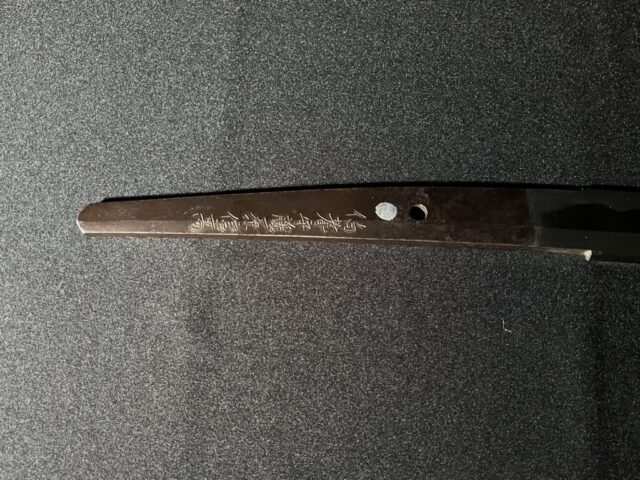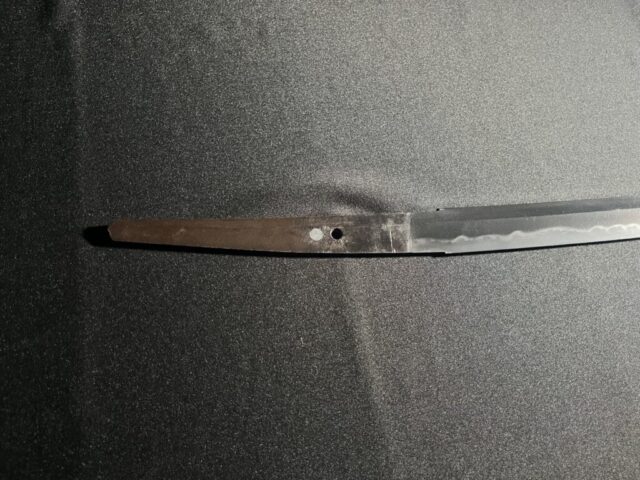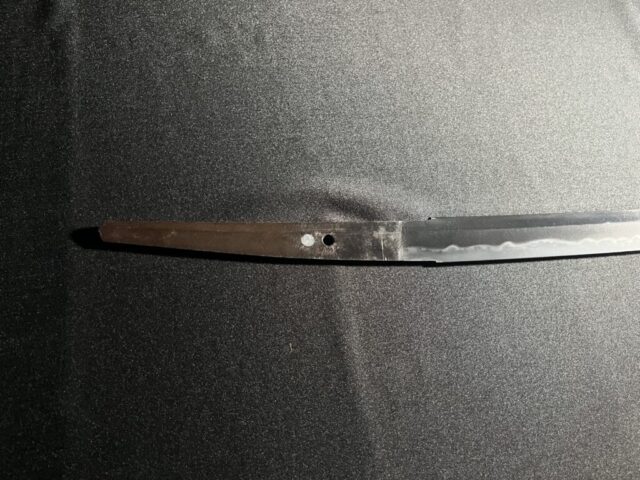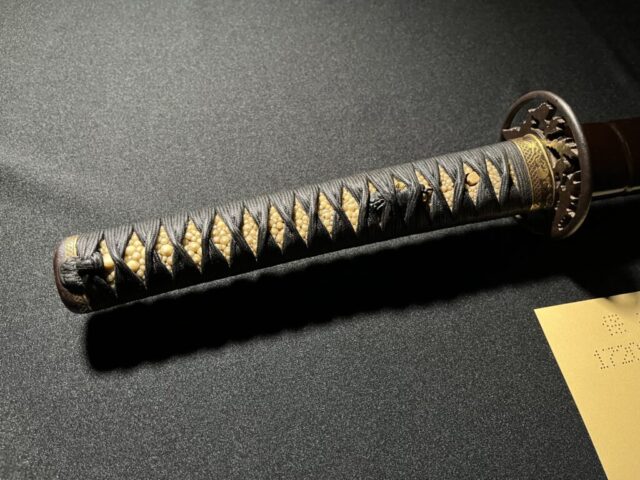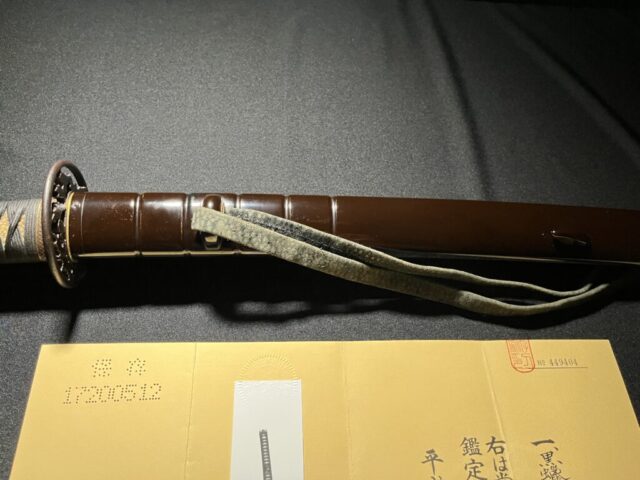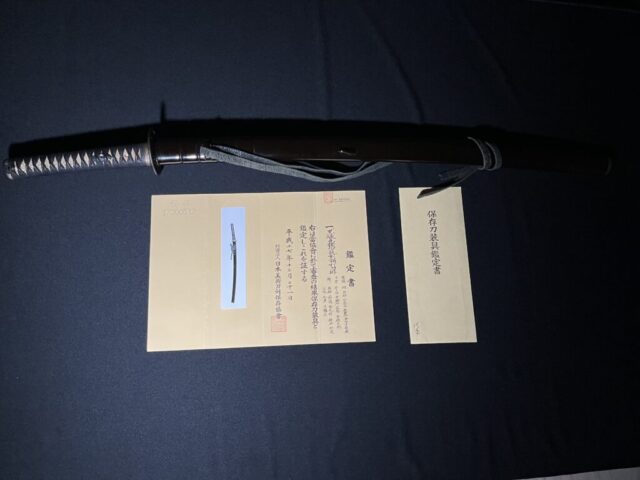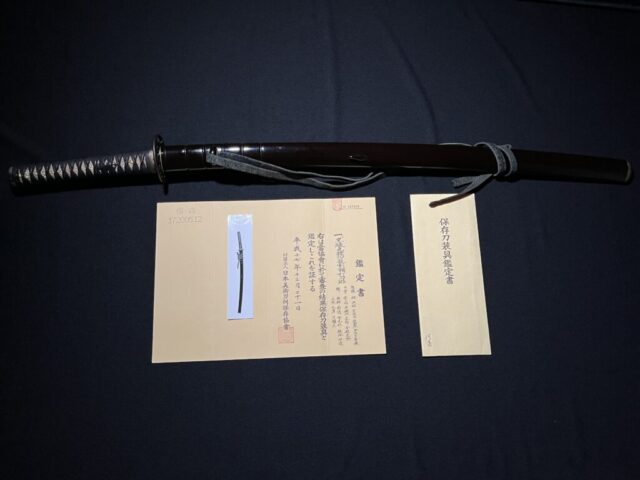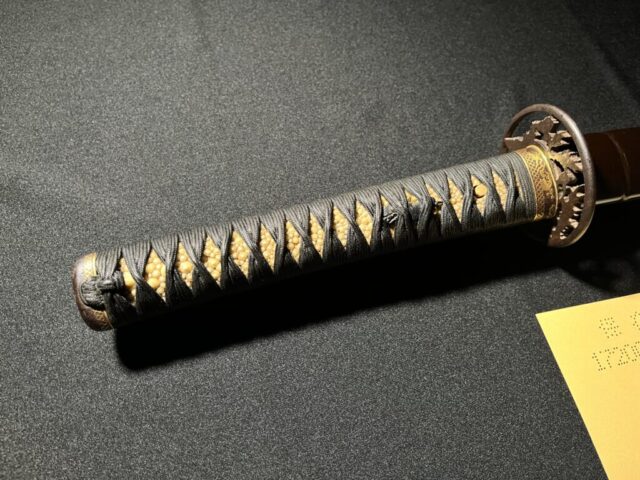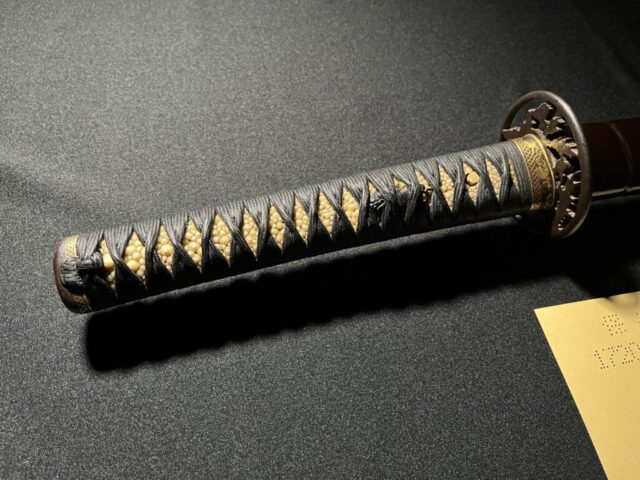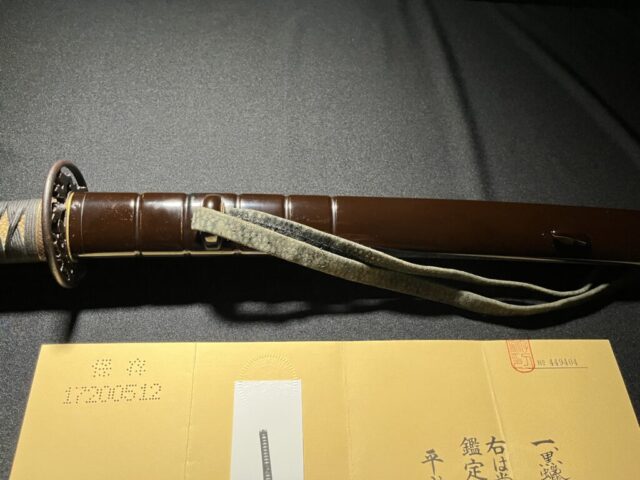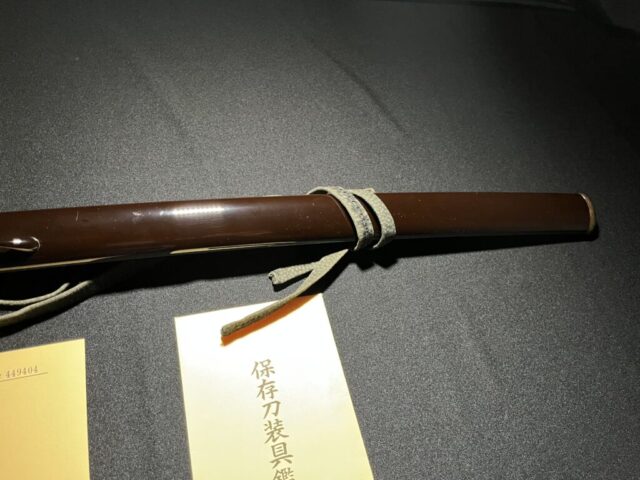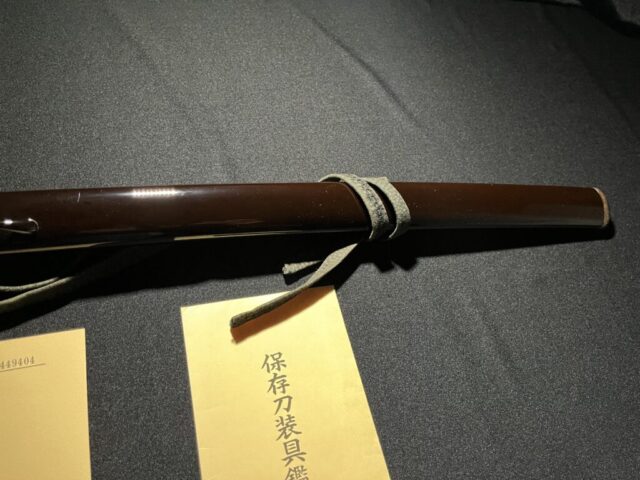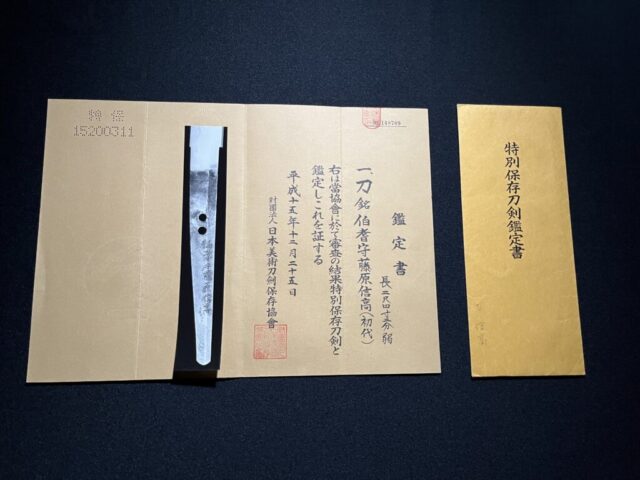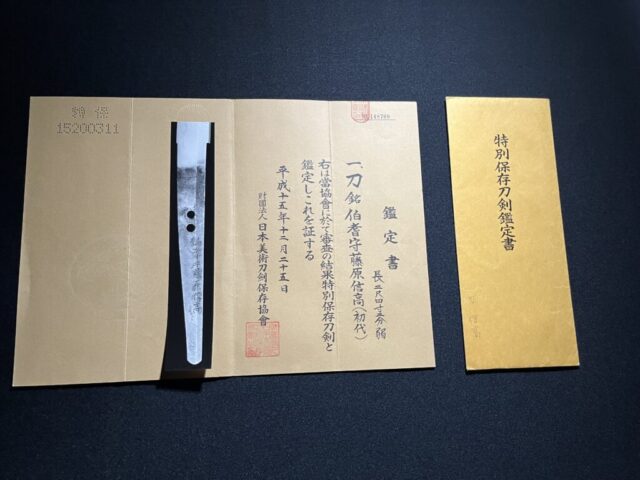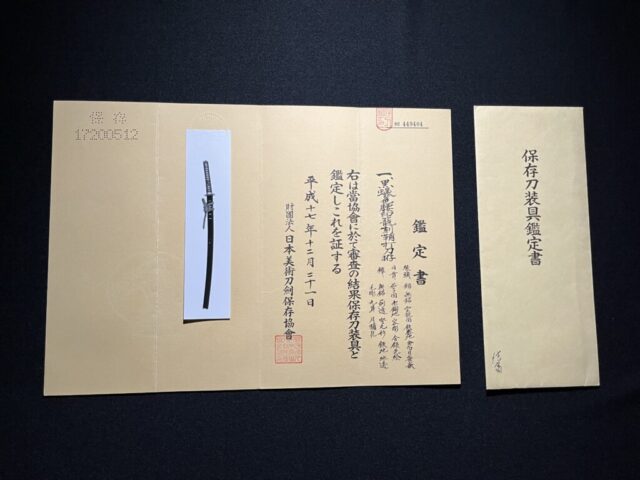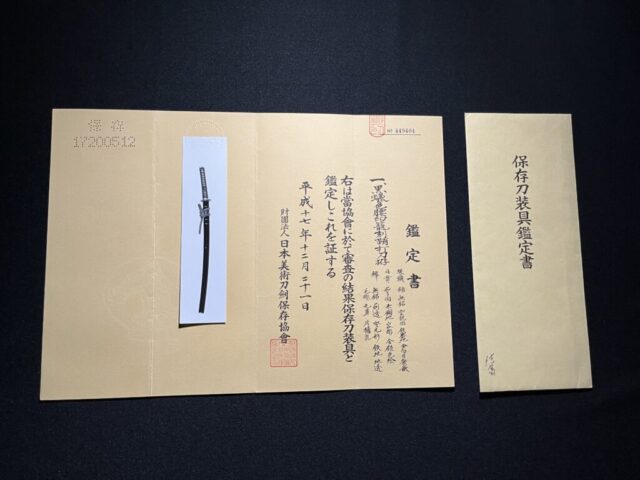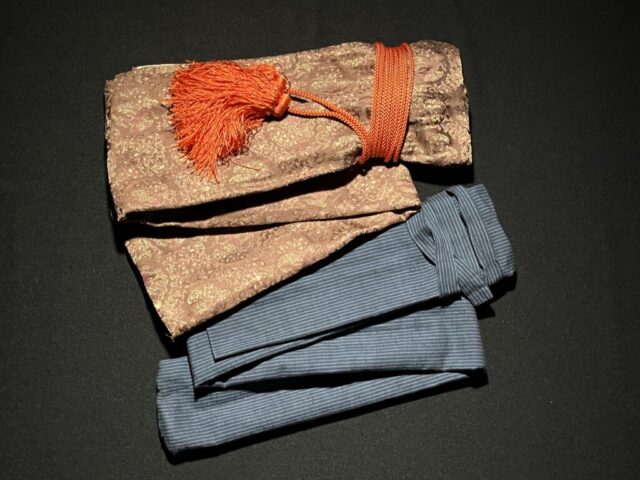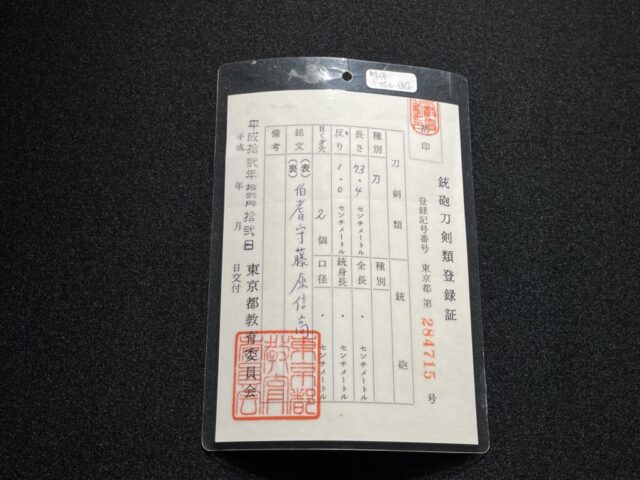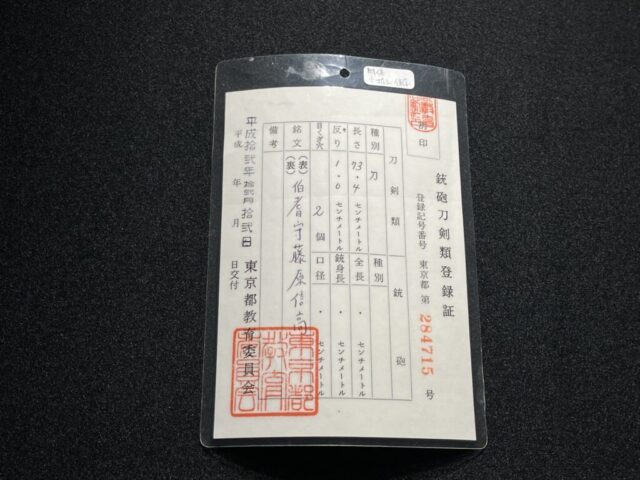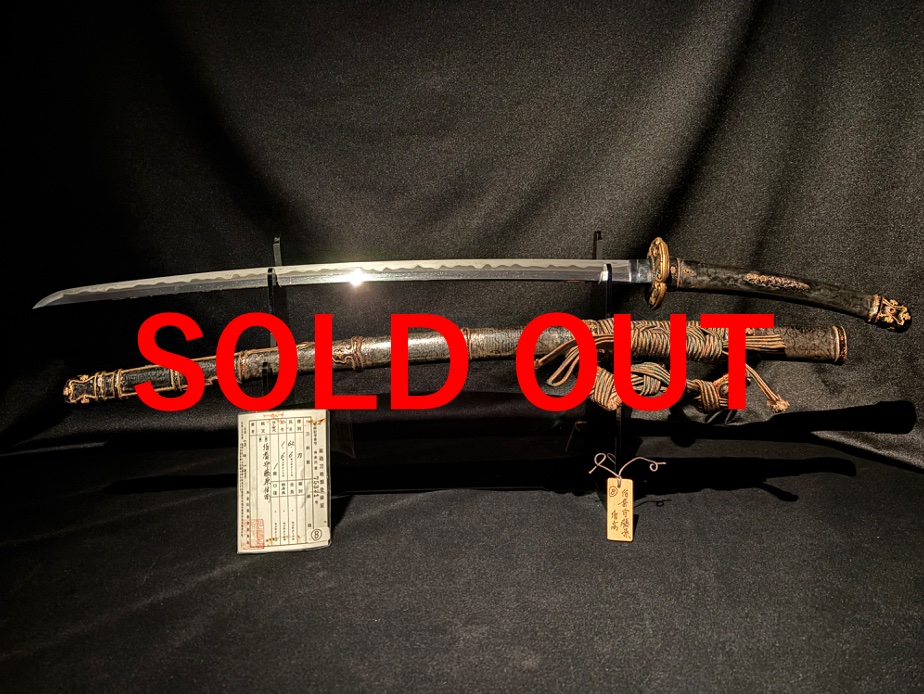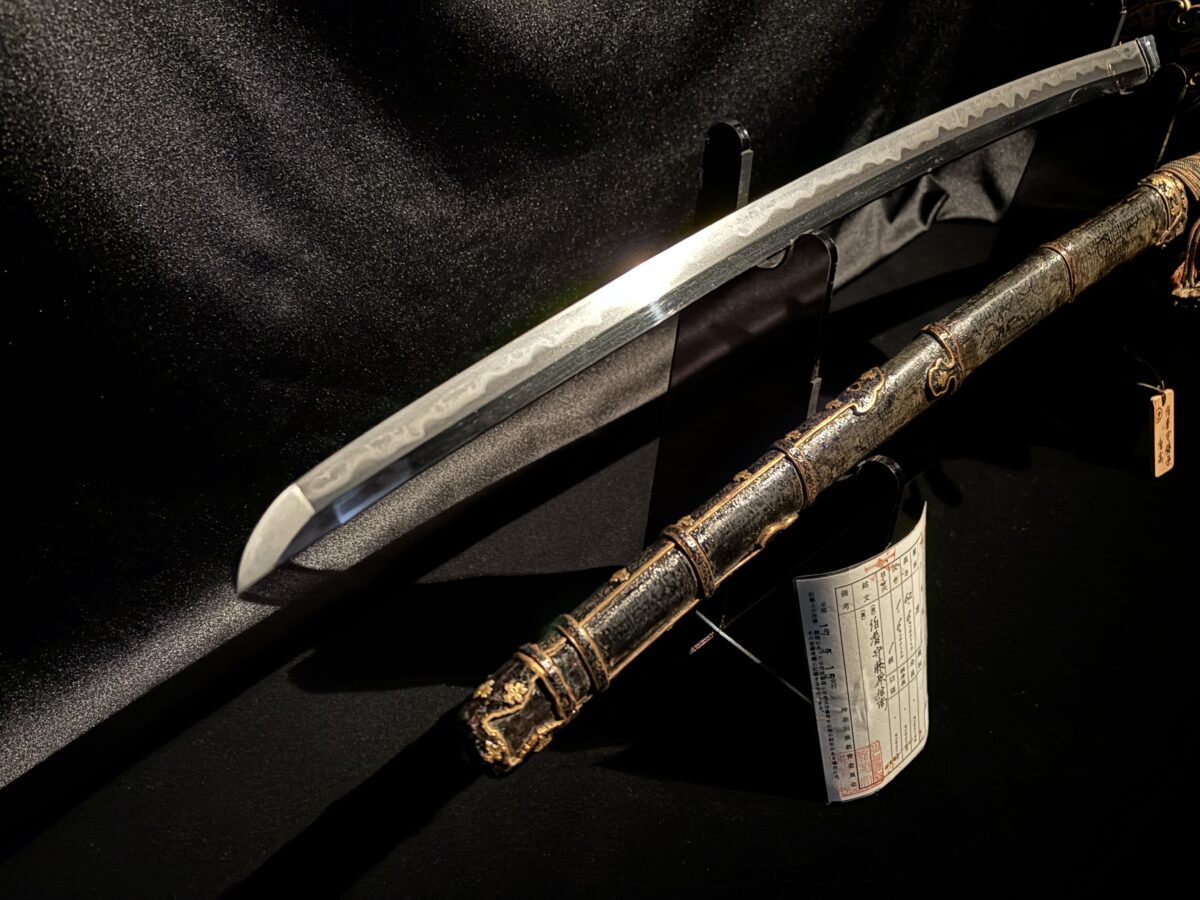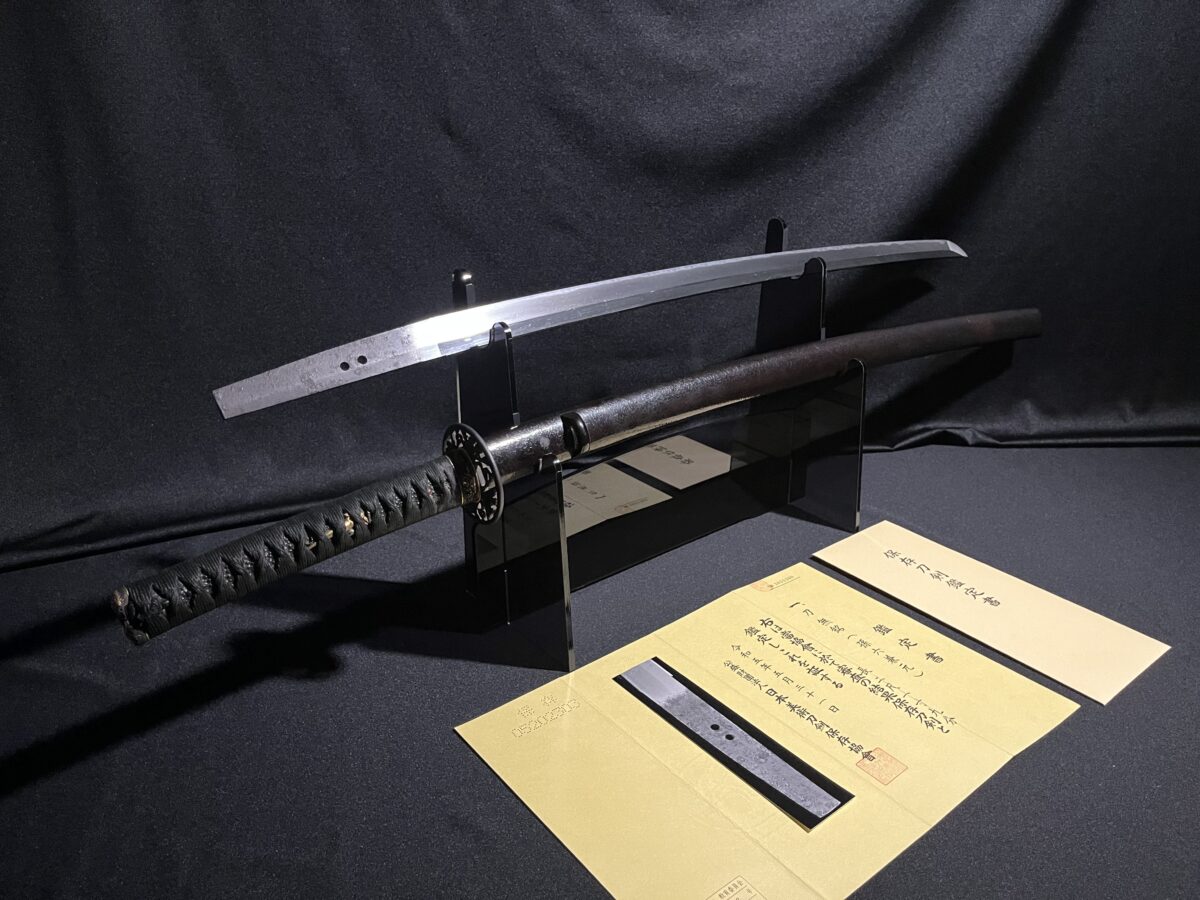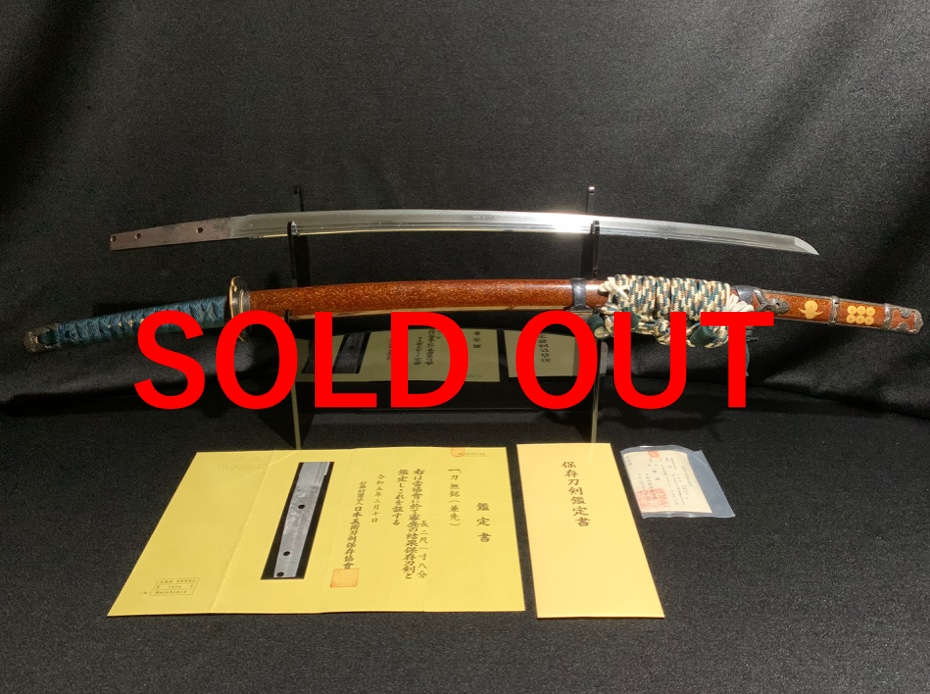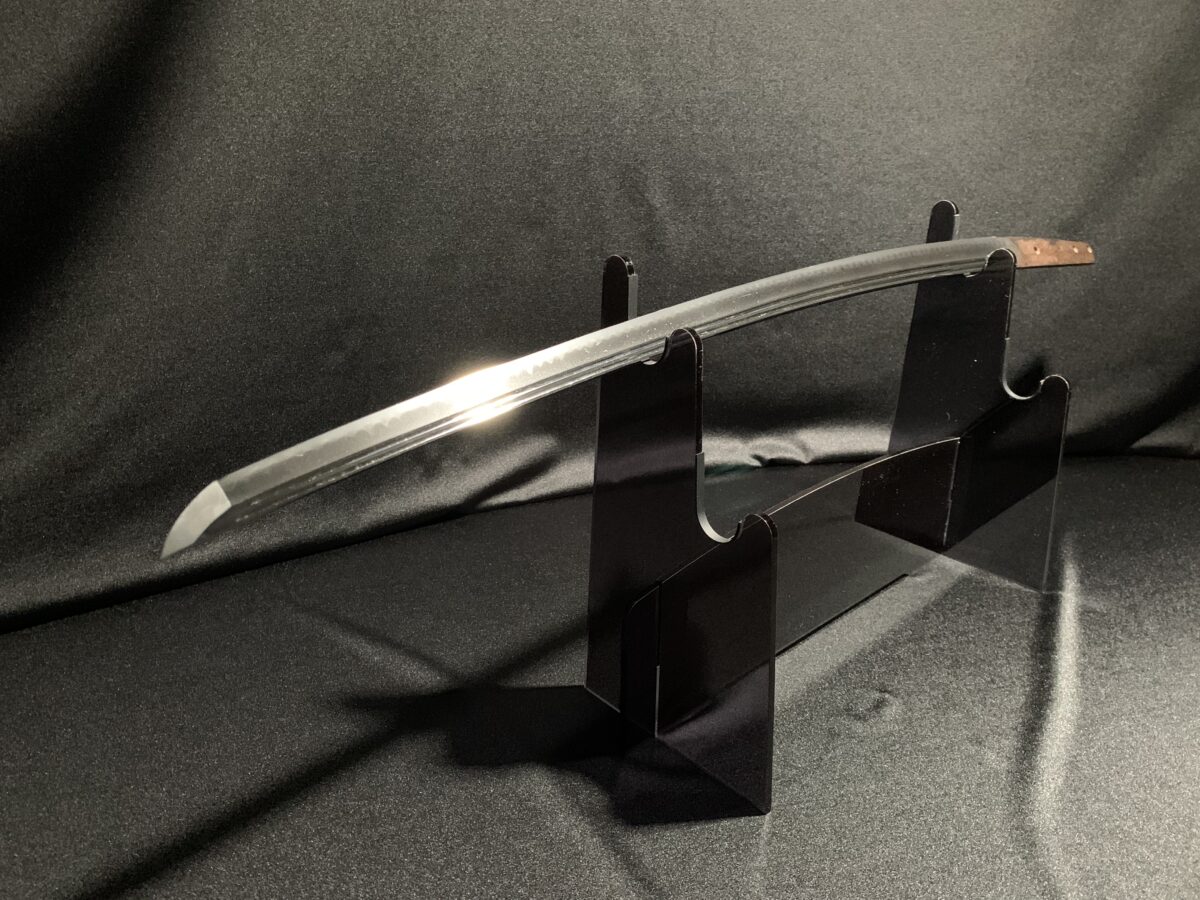Nobutaka 1st Generation(信高初代) – Authentic Katana(1610-1636)
Description
From the Katana Enthusiast

Hoki no Kami Nobutaka(伯耆守信高), the first generation, is a renowned swordsmith who is counted among the three most distinguished craftsmen of Owari Province(尾張国, present-day western Aichi Prefecture). Both the blade and the Koshirae(拵え, the sword mounting)are in excellent condition, and each comes with a certificate issued by the NBTHK (The Society for the Preservation of Japanese Art Swords).
Katana Certificate of Authenticity and Registration
This Katana has been certified as a “Tokubetsu Hozon Token(特別保存刀剣)” by the most prestigious organization, NBTHK(The Nihon Bijutsu Token Hozon Kyokai).
“Tokubetsu Hozon Token(特別保存刀剣)” is a higher grade than “Hozon Token(保存刀剣)”
The certificate paper is included in the set.
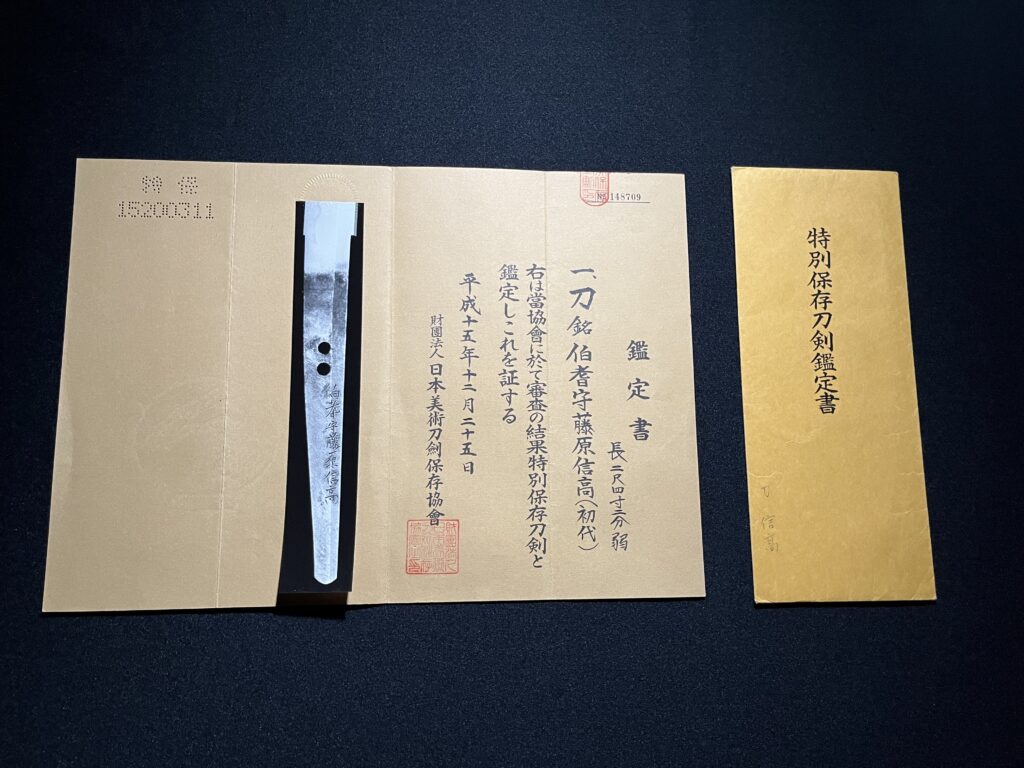
The Koshirae(拵え, the sword mounting) has been certified by the NBTHK as a “Hozon Tosogu(保存刀装具, Preserved Sword Fittings)”.
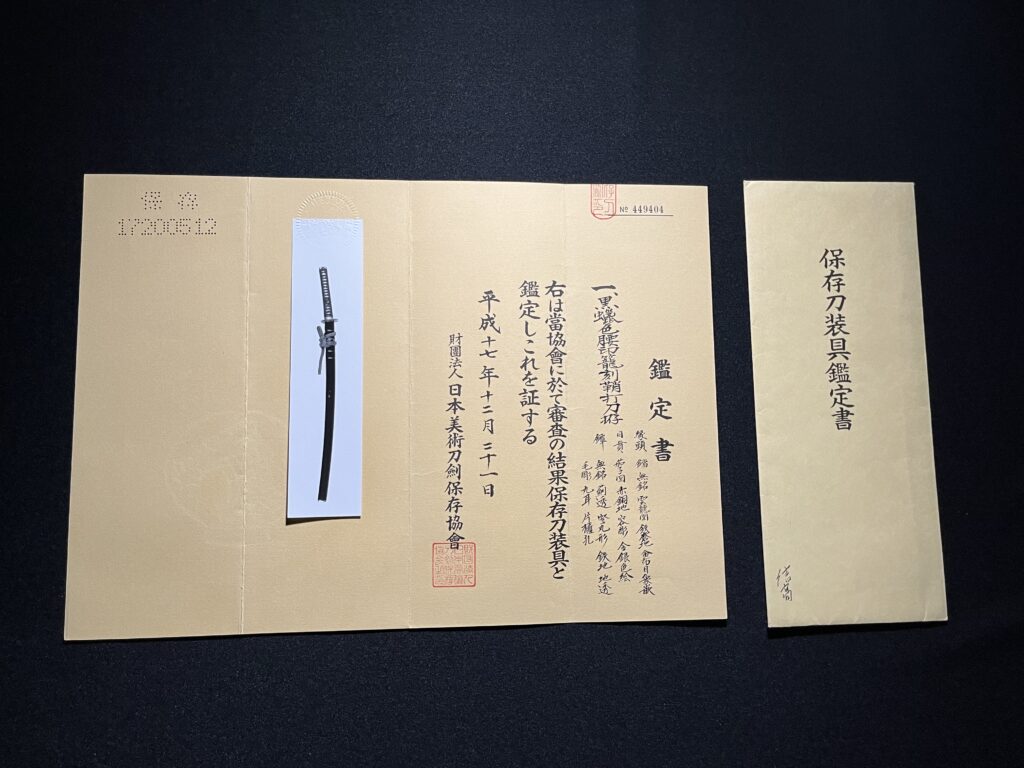
Authentic Katana are registered with the board of education of each prefecture. The original registration certificate cannot be sent as it must be returned to the Board of Education, but we will send you a copy enclosed.
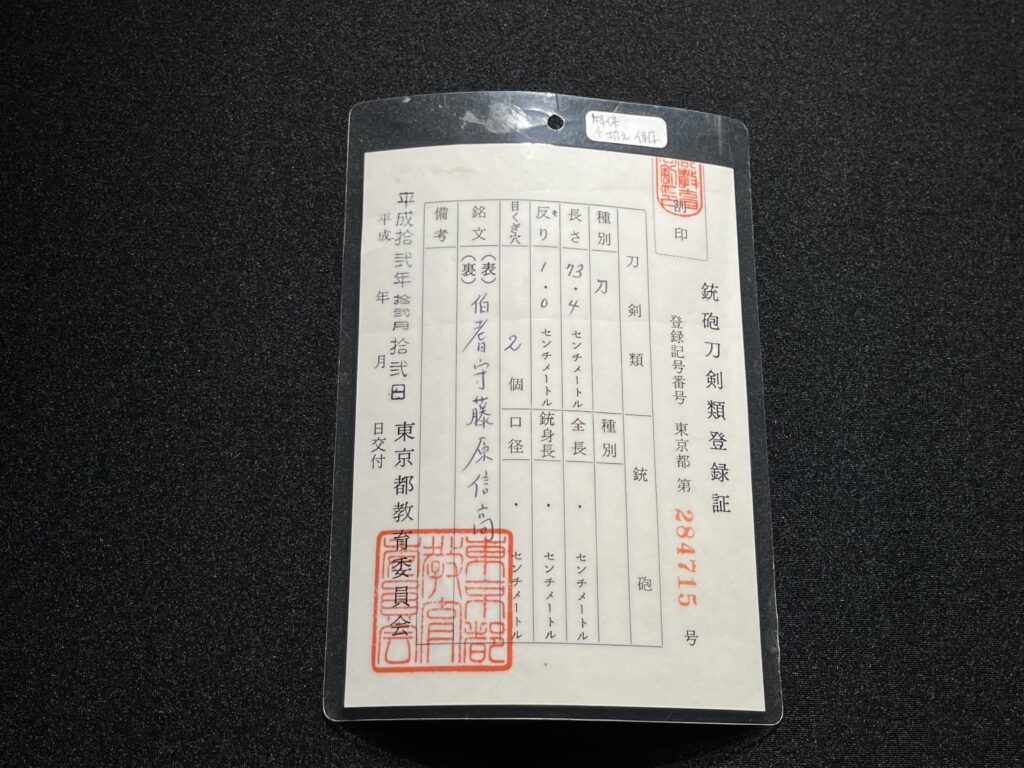
Each part of the Katana
1. Toshin(刀身)
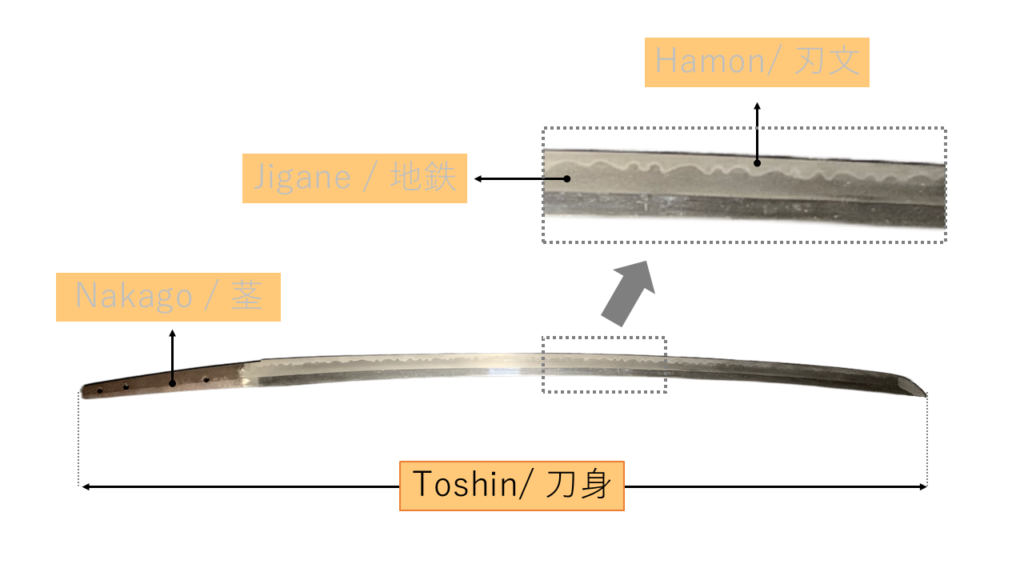
Toshin means the entire blade of a sword.
The length, of course, and especially the sori (how curved it is) is an important point in appreciating Katana.
The sori allows the Japanese sword to be unbreakable and unbendable. Furthermore, it can effectively cut objects with less force.
The detailed theory is explained in the article below, if you are interested.
【Toshin of this Katana】
Blade length: 73.4cm
Width(Motohaba) : 3.05cm
Thickness(Motokasane) : 0.72cm
Weight : 0.75kg
Curvature(Sori): 1.0cm
2. Hamon(刃文)
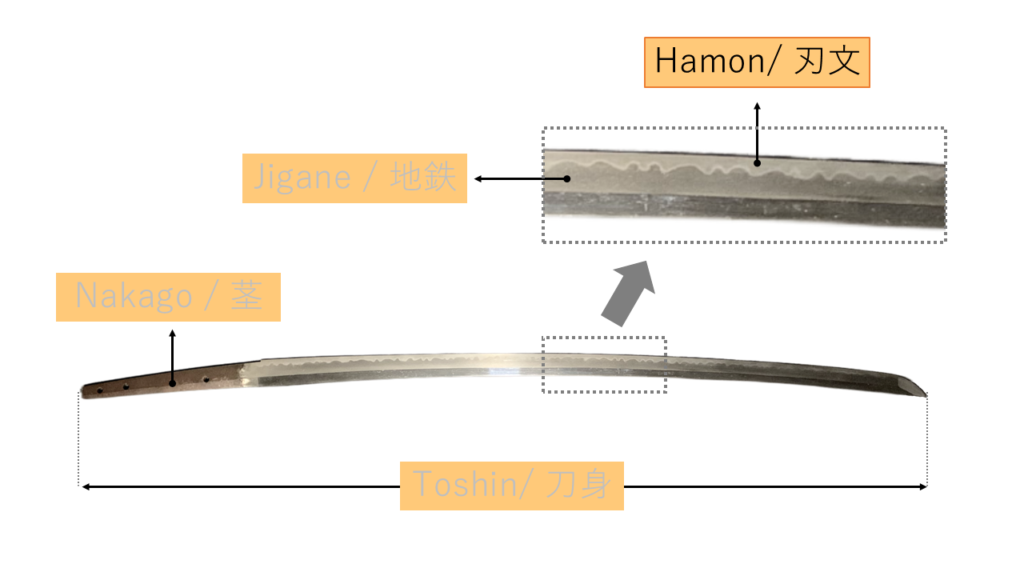
Hamon is a white wave-like pattern that appears on the edge of Authentic Katana blade.
Hamon is divided into two main types: the straight “Suguha” and the wavy “Midareba”.
Although it will be further classified in detail, Hamon is one of the important appraisal points because it represents the characteristics of the swordsmith.
It is also recommended to find Authentic Katana with the Hamon of your choice, as it is an element that is easy to enjoy visually.
【Hamon of this katana】
3. Jigane(地鉄)
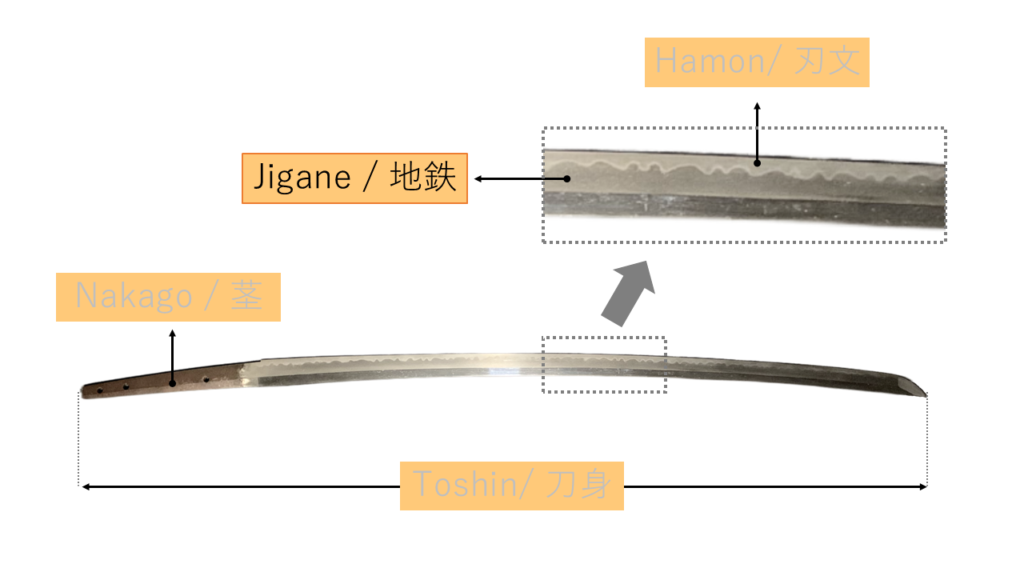
Jigane is a delicate pattern found on the surface of Katana. It appears when “tama-hagane-steel” made from iron sand, the raw material, is folded and smelted.
Each Katana has its own original pattern, which we can enjoy.
【Jigane of this katana】
4. Nakago(茎)
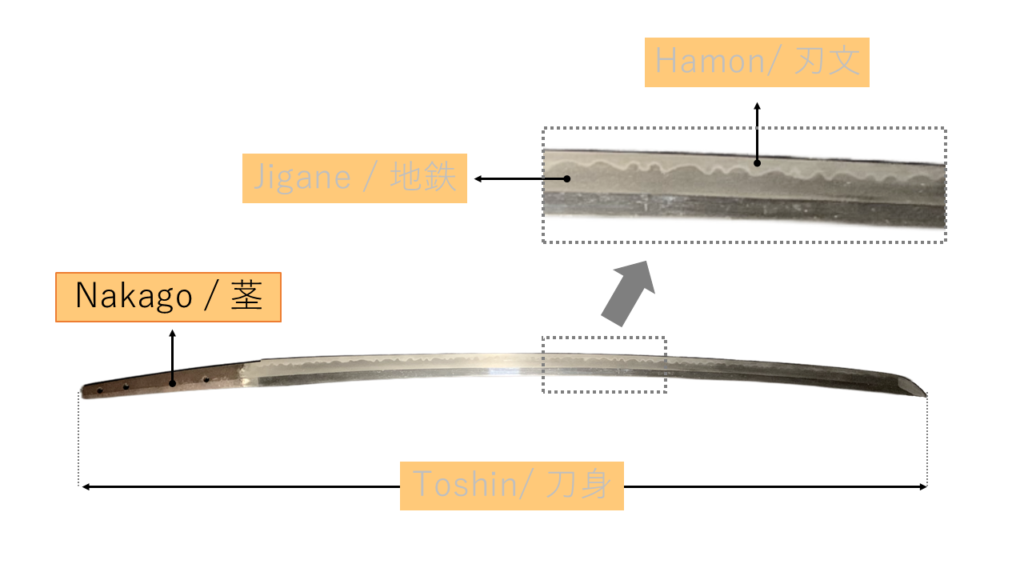
Nakago is the grip part of Authentic Katana.
It is often engraved with a mei (銘) that contains information such as the swordsmith’s name and the date of production.
【Nakago of this katana】
5. Tsuba (鍔)
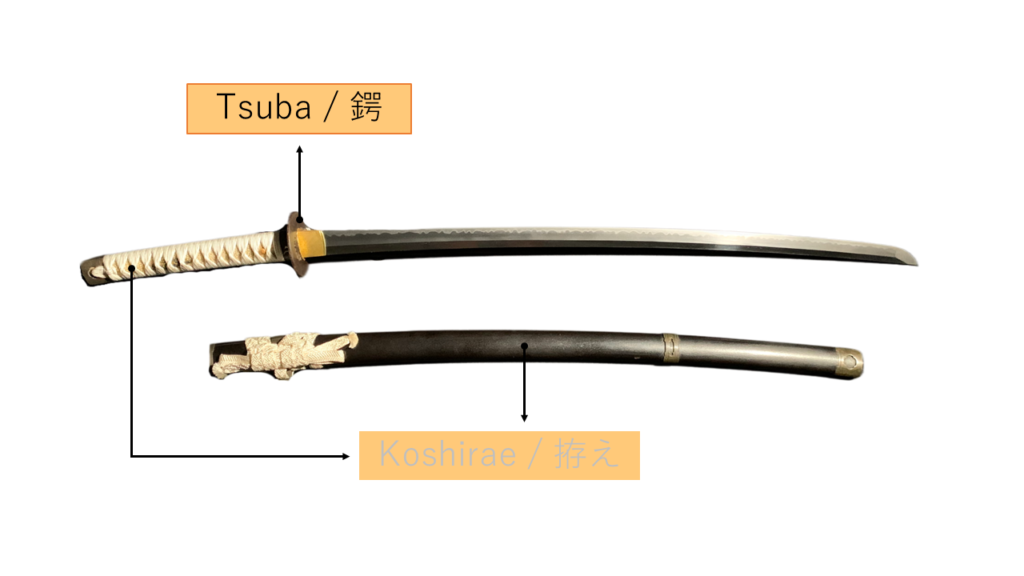
Tsuba is a metal fitting between Toshin and the handle that protects the hand holding the handle from the enemy’s blade when slashing with the opponent. Conversely, it also prevents your hand from slipping toward the blade when slashing with the Katana.
Furthermore, it also serves to adjust the center of gravity of the Katana.
There are many types of Tsuba, some of which are decorated and have value not only as a practical item but also as a work of art. Some Tsuba alone are designated as national important cultural properties.
【Tsuba of this katana】
6. Koshirae(拵え)
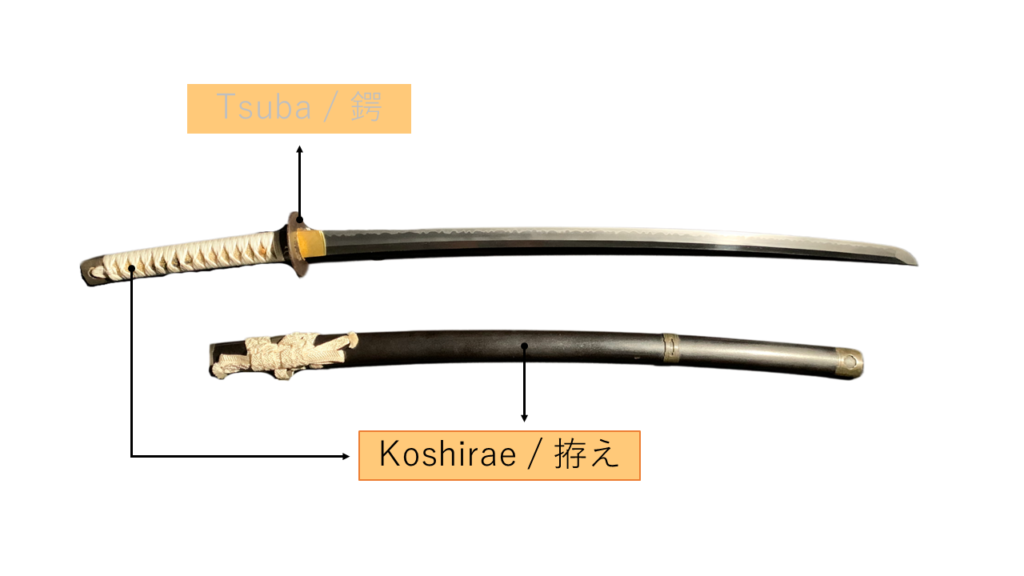
Koshirae is a generic term for the exterior of a Katana, including the handle, Tsuba, and scabbard.
Koshirae are broadly divided into Uchigatanakoshirae(打刀拵) and Tachikoshirae(太刀拵). Since each Katana is different in length and curvature, a unique Koshirae is made to suit each Katana.
The koshirae itself is an important work of art. We hope you will enjoy it with your Katana.
【Koshirae of Tis Katana】
About Hokinokami Fujiwara Nobutaka 1st generation(伯耆守藤原信高 初代)
Hokinokami Fujiwara Nobutaka 1st generation is a swordsmith ranked Jyosaku(上作) in Shinto(新刀).
He is a master craftsman, one of the “Owari Sansaku” (three famous master craftsmen of Owari Province).
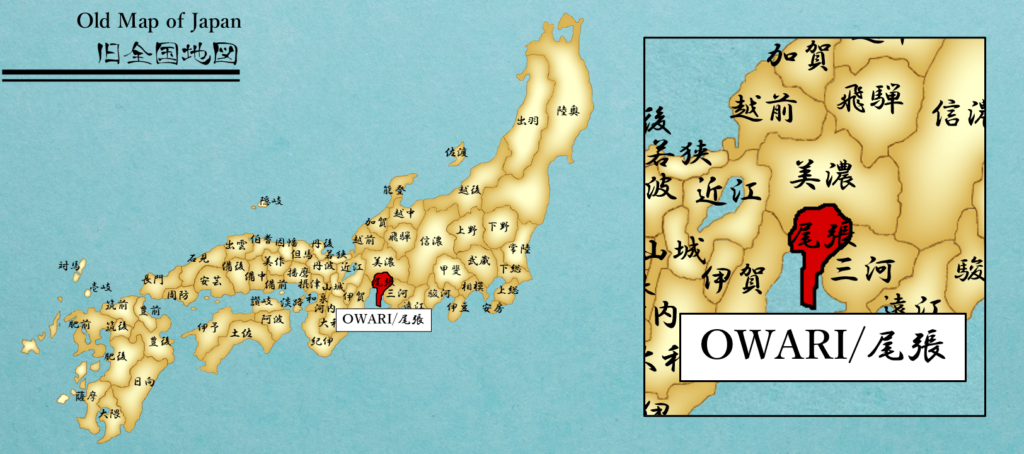
Nobutaka 1st generation served and forged swords for Oda Nobunaga(織田信長) when he lived in Kiyosu. It is said that he was favored by Oda Nobunaga and given the character for “信”.
In 1581, he received the title of Hokino-kami(伯耆守), and in 1610, he moved to the town of Nagoya Castle following Tokugawa Yoshinao(徳川義直), the first lord of the Owari Domain, and made swords.
Nobutaka 1st generation passed the reigns of the family to Nobutaka 2nd generation at the age of seventy-three and died at the age of seventy-six, and since then the Nobutaka family has been deeply protected by the Owari Tokugawa family, and its name continues until the end of the Edo period.
From the Gokaden Lineage: Mino-den Roots
Many Japanese swords trace their roots back to one or more of the five major traditional schools of swordsmithing, known as the Gokaden(五箇伝).

These five traditions—Yamato, Yamashiro, Bizen, Soshu, and Mino—each developed in different historical provinces and are known for their distinct styles and characteristics.
This sword is rooted in the Mino-den(美濃伝) tradition.
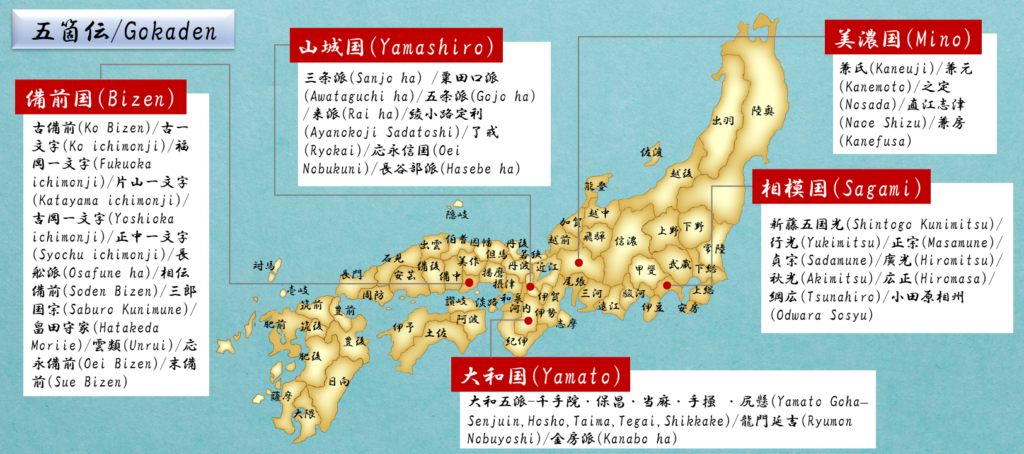
Mino-den emerged in Mino Province (present-day southern Gifu Prefecture) in the early Muromachi period. With the rise of the Sengoku era and the increasing demand for functional swords, Mino swordsmiths gained prominence by producing high-quality blades optimized for actual combat, often on a large scale.
The region saw an influx of smiths influenced by Yamato-den and Yamashiro-den traditions, and the fusion of these techniques contributed to the development of Mino’s practical and balanced sword-making style.
In particular, the town of Seki became a major hub, giving rise to a large number of smiths whose works became widely known as Seki-mono (関物, Seki swords).
Rather than focusing on flamboyant visual flair, Mino swords are appreciated for their structural beauty and practicality, with a strong sense of reliability and balance. This tradition’s emphasis on function, combined with its rich historical background, makes Mino-den swords highly attractive—both for first-time buyers and seasoned collectors alike.
Buyer’s Tips
Authentic Katana are limited in number and we want this to be received by a great buyer who deserves to hold it in their hands.
Before purchasing an item, please review the buyer’s guide here.
Shipment
1.Time required for delivery
This is a truly domestic Japanese sword that has never left Japan. To export, we need to obtain an export permit from the Agency for Cultural Affairs.
It takes about 25 business days from the time the buyer makes payment to the time the transportation process begins.

It takes approximately 7 to 20 days from the time of shipment to arrival, depending on the destination country.
2.shipping charges
Shipping is free of charge.
Basically, we ship to any country except China and Russia.
3.Regarding imports
Please check with your local customs authorities regarding the importation of Japanese swords. We are not responsible for items held or rejected by customs in the destination country.
Please refer to the following page for more information on shipping.
Payment
You can pay through the PayPal link below or transfer the money to the bank account below.
All prices are tax-exempt and do not include Japanese consumption tax.
This applies to international purchases only.
Please note that customs duties or import taxes may apply depending on your country’s regulations. Buyers are responsible for any such charges.
direct payment by bank transfer
Frequently Asked Questions (FAQ)
If you have further questions, feel free to contact us directly.
Do you ship internationally?
Yes, we ship authentic Japanese swords worldwide. Even if we do not have a delivery record to your country, we will do our best to arrange secure delivery.
Currently we do not ship to China or Russia.
Is shipping really free?
Yes. All listed prices include complimentary international shipping. No additional delivery fees will be charged.
How long will it take to receive my sword?
Because we must obtain export approval from Japan’s Agency for Cultural Affairs, it takes about 25 business days to begin shipping. Including transit time, please allow 1–2 months for delivery.
Are the swords already exported items?
No. Every sword we offer has remained in Japan since its creation and is being exported for the first time.
Are the swords legally exported?
Absolutely. We follow all Japanese regulations and obtain official export permits before shipment.
Do I have to pay customs duties or taxes?
Import duties or taxes may be levied by your country’s customs authority. Buyers are responsible for any such charges. Please check locally in advance.
Can I return a sword after purchase?
Returns and exchanges will not be accepted unless agreed upon between the Company and the User.
How do you select the swords you sell?
Our team consists of katana enthusiasts with backgrounds in metallurgy and history. We hand-select each blade for authenticity, condition, and cultural value.
How can I trust that the sword is real?
All swords are genuine antiques, many with registration or appraisal documents. We do not handle replicas or mass-produced blades.
Are these swords actually sharp and functional?
Yes. Our swords are authentic Japanese katana forged by traditional methods and possess a level of sharpness that has been revered for centuries. They are not decorative replicas—they are real blades capable of cutting. Please handle with the utmost care to avoid injury or damage.
I’m looking for something specific. Can I request it?
Certainly. Please contact us with your requirements—design, smith, school, era, condition—and we will be happy to assist.

